Identifying morel mushrooms is relatively easy, as they have a distinct look and grow at very specific times of the year. However, once you start looking closer, it gets much more complicated. Knowing the morel species is helpful in many ways, though, even before you start foraging.
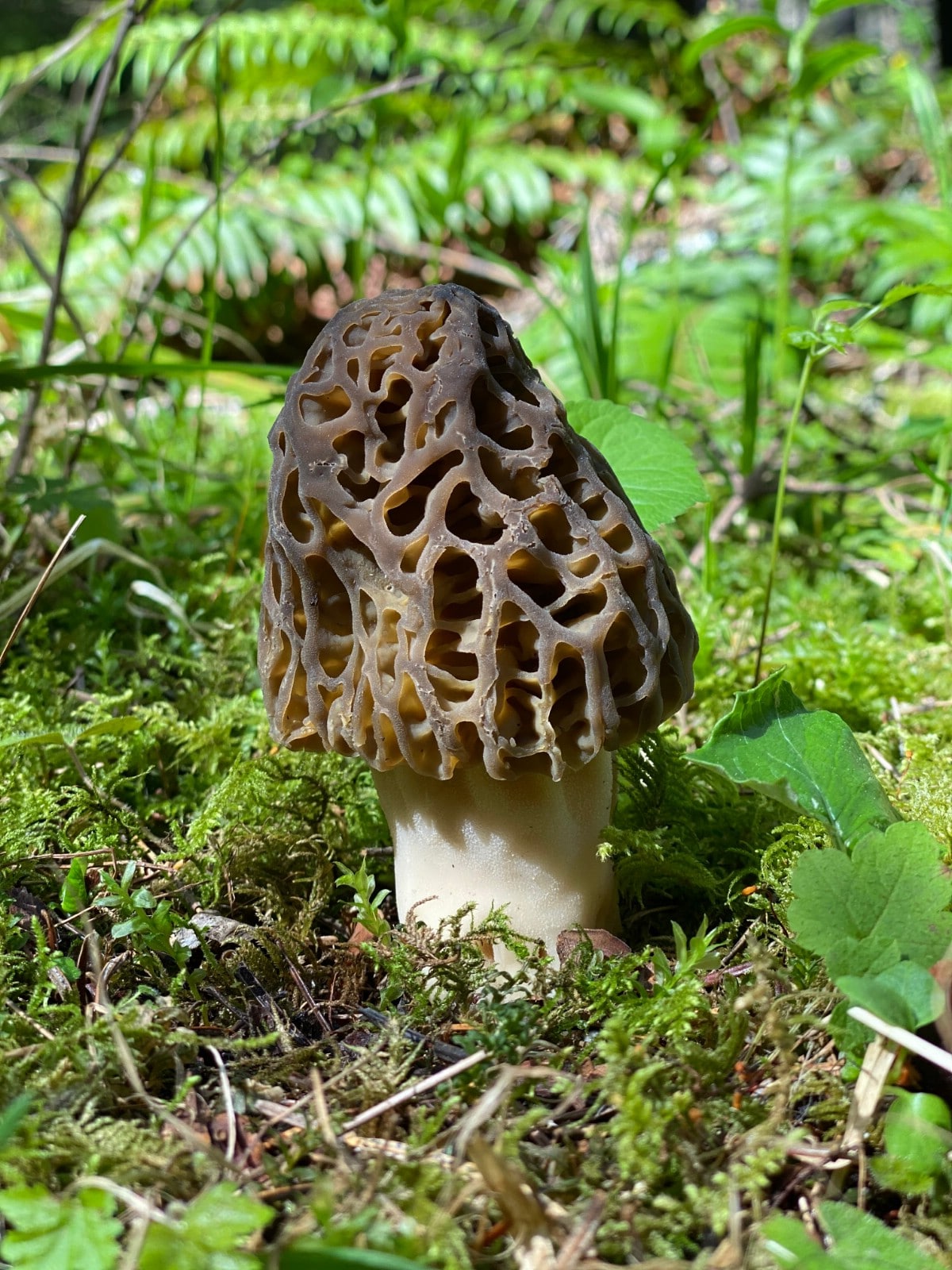
For centuries, morels were identified by their coloring – foragers referred to them as black morels, yellow morels, gray morels, or greenies. Recent studies show there are much more than the 3 or 4 types categorized previously. And, there likely are more to be “discovered” in the future. The most recent study actually classified 19 species, but one isn’t fully described yet.
Thankfully, all the morels are perfectly edible (and delicious!), so it doesn’t matter if you know the proper scientific name or designation before consuming them.
So many different variables come together to create the mysterious morel! As science and amateur observation moves forward, so will our understanding of this prized mushroom.
Jump to:
- Why Knowing The Morel Species Is Important For Foraging
- How Many Morel Species Are There In North America?
- Morel Anatomy
- About Yellow Morels
- About Black Morels
- About White Morels
- Black morels vs. Yellow vs. White Morels
- Nationwide Morels
- Eastern Morels
- Western Morels
- Morel Mushroom Trivia
- Morel Mushroom Common Questions and FAQs
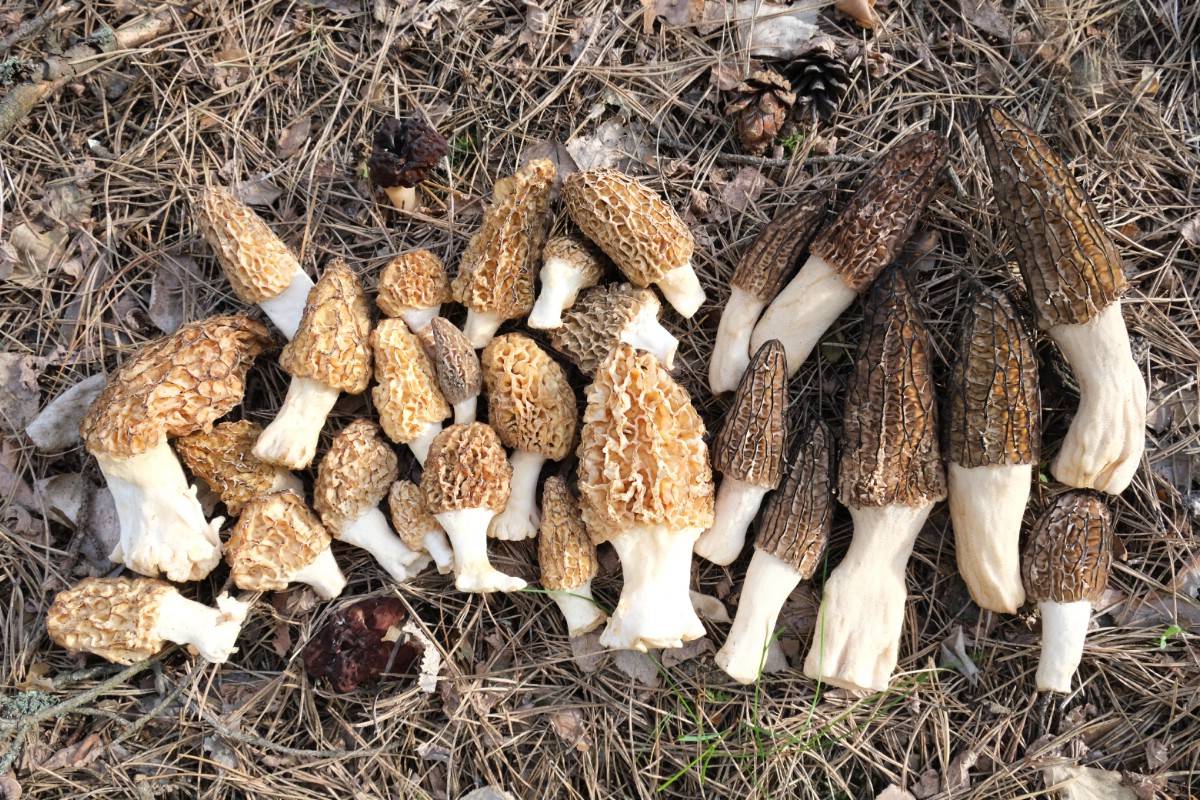
Why Knowing The Morel Species Is Important For Foraging
- Not all morel species associate with the same trees – or trees at all. In fact, there is a wide range in habitat preferences and even some “landscape morels” that don’t rely on a tree host – you’ll have better luck if you’re looking in the right place. Learn which trees to look about with our in-depth look at trees and morels.
- Burn morels grow differently than other morels.
- Morel season varies based on location and species type. Know the season for the morels in your region, and you’ll be much more successful.
- There are three different “types” of morels – knowing which ones fruit in your area will lead to better foraging.
For tips on a successful morel hunt and information about lookalikes, check out these posts — Helpful Morel Hunting Tips and Secrets and False Morel Mushrooms – Everything You Need to Know. And, once you’ve found those morels, learn about all about the proper morel harvesting and preparation techniques!
How Many Morel Species Are There In North America?
At this moment, there are 18 described species of morels in North America:
- 12 types of black morels that vary widely in location, color, size, and ease of identification.
- 5 species of yellow morels, the most common morels foragers find
- 1 species of white morel, found on the west coast.
Morel Anatomy
The morel mushroom has a stubby-looking white stem with an oddly-shaped tall conical or egg-shaped cap. The cap is honeycombed, with ridges and indentations covering it entirely. Upon closer inspection, the cap actually fits around the tall stem like a hat that has been pulled down all the way.
The caps attach to the stem at the lowest point and can easily be dislodged or disrupted if they are handled too much.
To correctly identify a morel, you need to understand the difference between ridges and pits because their coloring varies across species. In addition, there are features that all morels share.
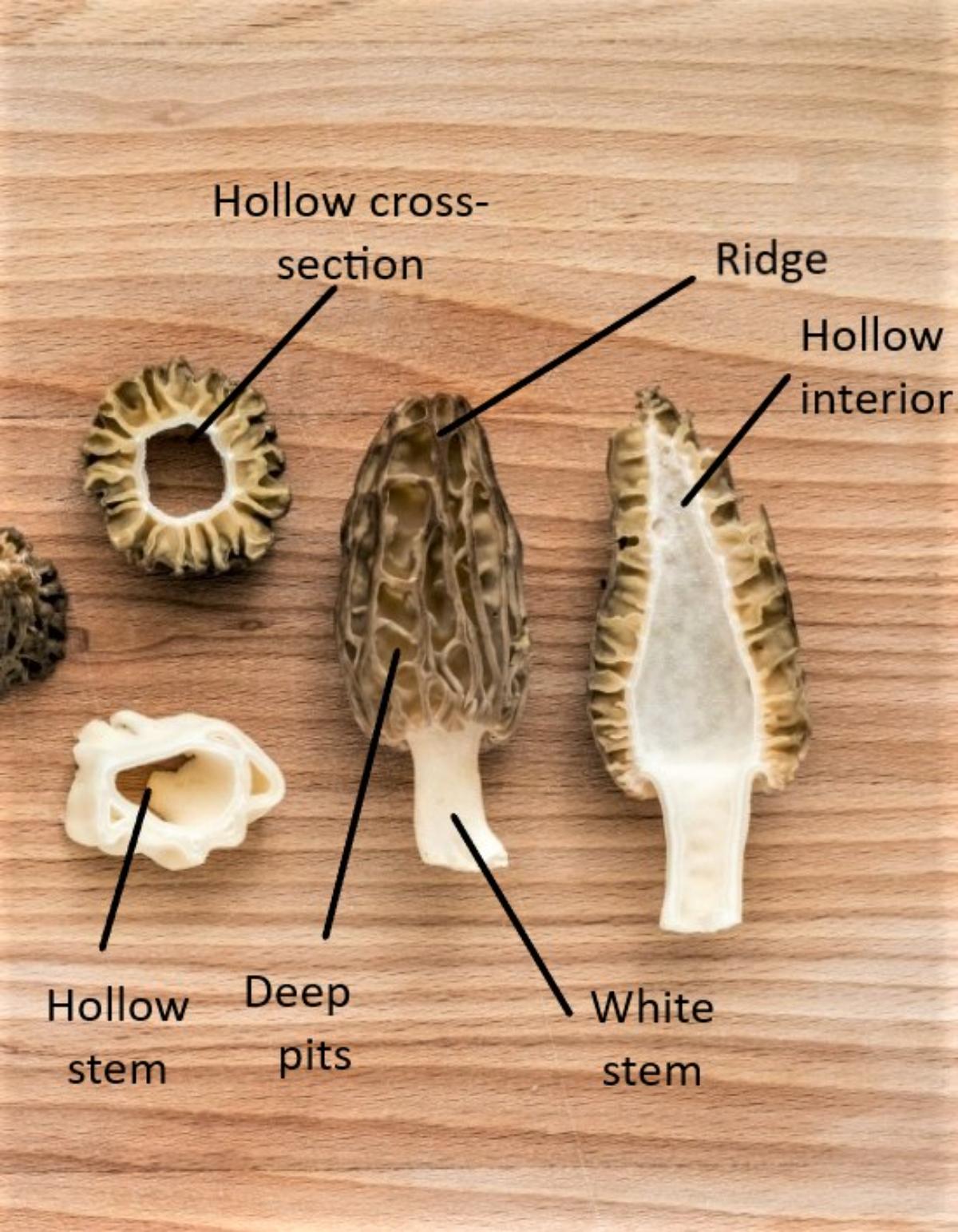
- Cap Ridges – The ridge is the upraised portion of the honeycomb pattern.
- Cap Pits – The pits are the indented portion of the honeycomb pattern.
- Stem – Morel stems are always white, cream-colored, or very slightly yellowish across all 18 species.
- Interior – Both the cap and stem are hollow, creating a long uninterrupted hollow tube from top to bottom. This is what sets the morel apart from potential look-a-likes.
- Cap and Stem Relationship – The caps attach to the stem at the lowest point and can easily be dislodged or disrupted if they are handled too much. In this case, the cap will fall right off.
Of course, being this is the natural world and fungi are complicated, two morel species don’t follow this rule. These two are half-morels, with caps that attach to the stem halfway down, causing the cap to look more bell-shaped.
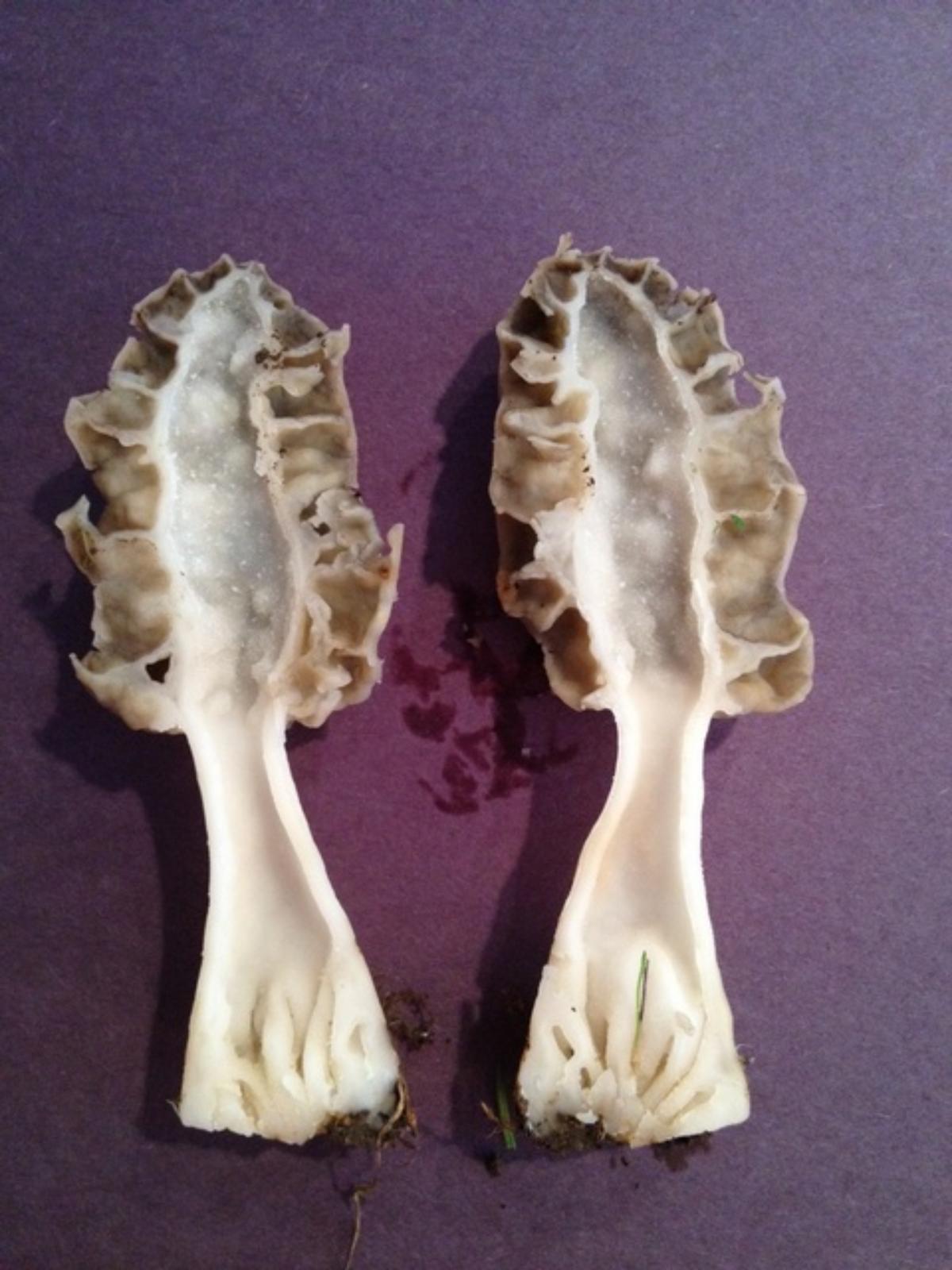
About Yellow Morels
There are five types of yellow morels, and they can be pretty hard to tell apart. Or, depending on where you live, it can be quite easy because there is only one possibility. The honeycombing on yellow morel caps is not vertical like with black morels. Instead, the honeycomb pattern is random without a specific orientation.
About Black Morels
All black morels have some basic characteristics in common. Their caps are conical, elongated, honeycombed, and covered in ridges with deep pits. The ridges and pits on black morels all run vertically down the cap.
The bottom of the cap is fused to the stalk, and in most cases, the cap is longer than the stem. The stem is generally a lighter color than the cap, usually a sandy yellow or whitish shade.
About White Morels
The white morel is unique in many ways. First of all, there is just one white morel in North America. Secondly, the white morel is saprobic, meaning it feeds off of dead or decaying organic material. This means that its growth is not tied to a tree species. In fact, it often doesn’t grow around trees.
Like all morels, the white morel has an elongated, honeycombed cap covered in ridges and deep pits. The stem and cap are both hollow, so it is hollow from top to bottom when you cut them open. The base of the cap is attached to the stem, and the cap is usually longer than the stem. The stem is white or off-white or tan in color.
This morel species can be cultivated, but so far, due to many reasons, it is not commercially viable yet. The process is ongoing with many folks making a go at it, but there are no morels in my supermarket yet!
Black morels vs. Yellow vs. White Morels
- Black – vertical ridges and pits, small groove where the cap attaches to stem, creating a “lip.”
- Yellow – randomly orientated ridges and pits, cap attaches to stem without a groove.
- White – mostly vertical ridges and pits, stains orangish or reddish-brown when bruised.
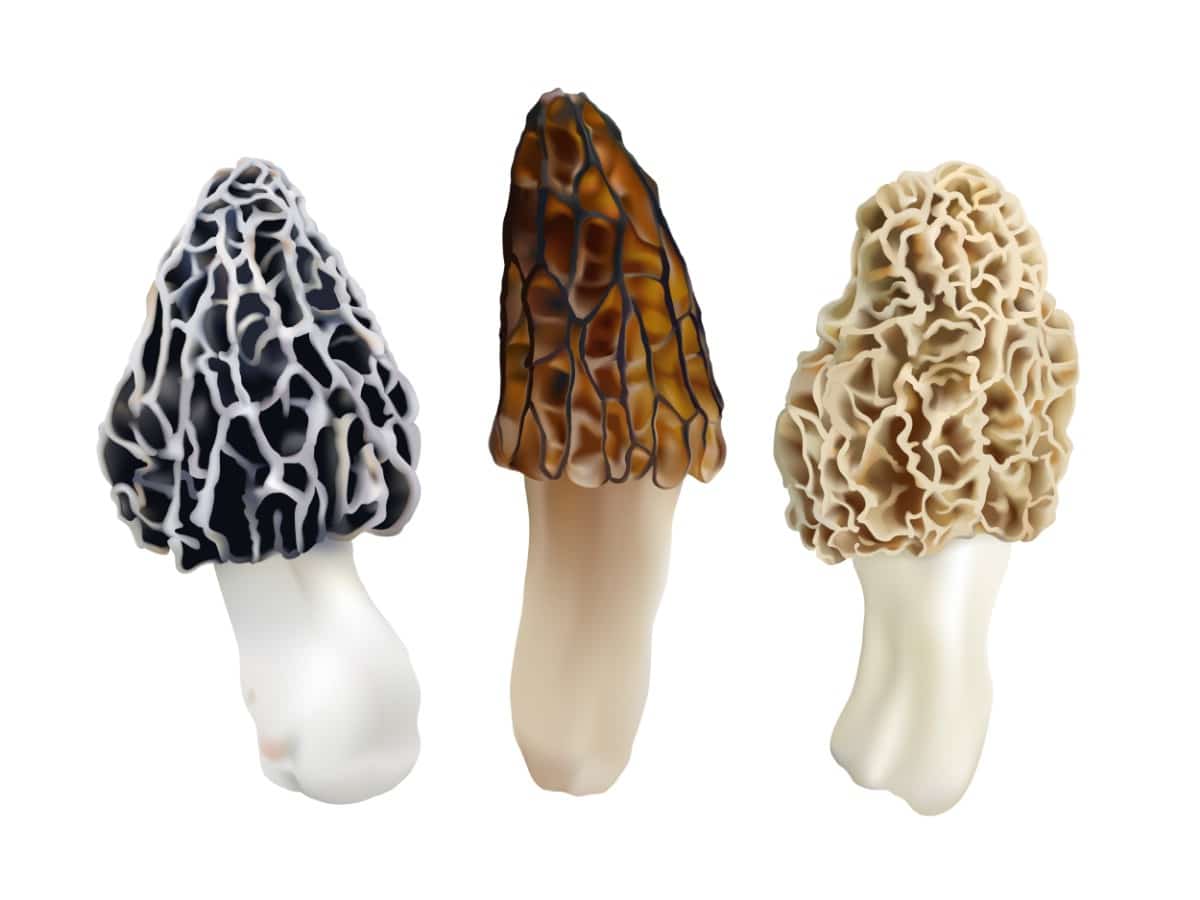
Notice the differences in ridge and pit arrangements.
Yellow Morel (left), Black Morel (middle), White Morel (right)
Nationwide Morels
Only one morel species grows all over North America. The scientific name of this morel is entirely appropriate given its unique status – Morchella americana! This coast-to-coast species is a yellow morel, and in addition to being widespread, it also grows with a wide range of trees. Most likely, this is why it grows in so many places – it isn’t so picky about tree hosts.
Morchella americana
Also known as M. esculentoides, this one can be found from the east to the west coast, north and south, and everywhere in-between.
- Region: North America, countrywide
- Season: Spring, March-May, depending on region and climate
- Habitat: Hardwoods, including cottonwood, ash, apple, pear, elm, and ash, but not limited to these.
- Size: Stem – ¾ – 4 ¾ tall; Cap – 1 – 4 ¼ inches long.
- Description: Egg-shaped or rounded cap. Randomly formed ridges white to pale yellow when young with gray to dark brown pits. In maturity, ridges turn yellowish-brown, as do the pits. Often called a gray morel because of its appearance when young. This species is the largest of the yellow morels.
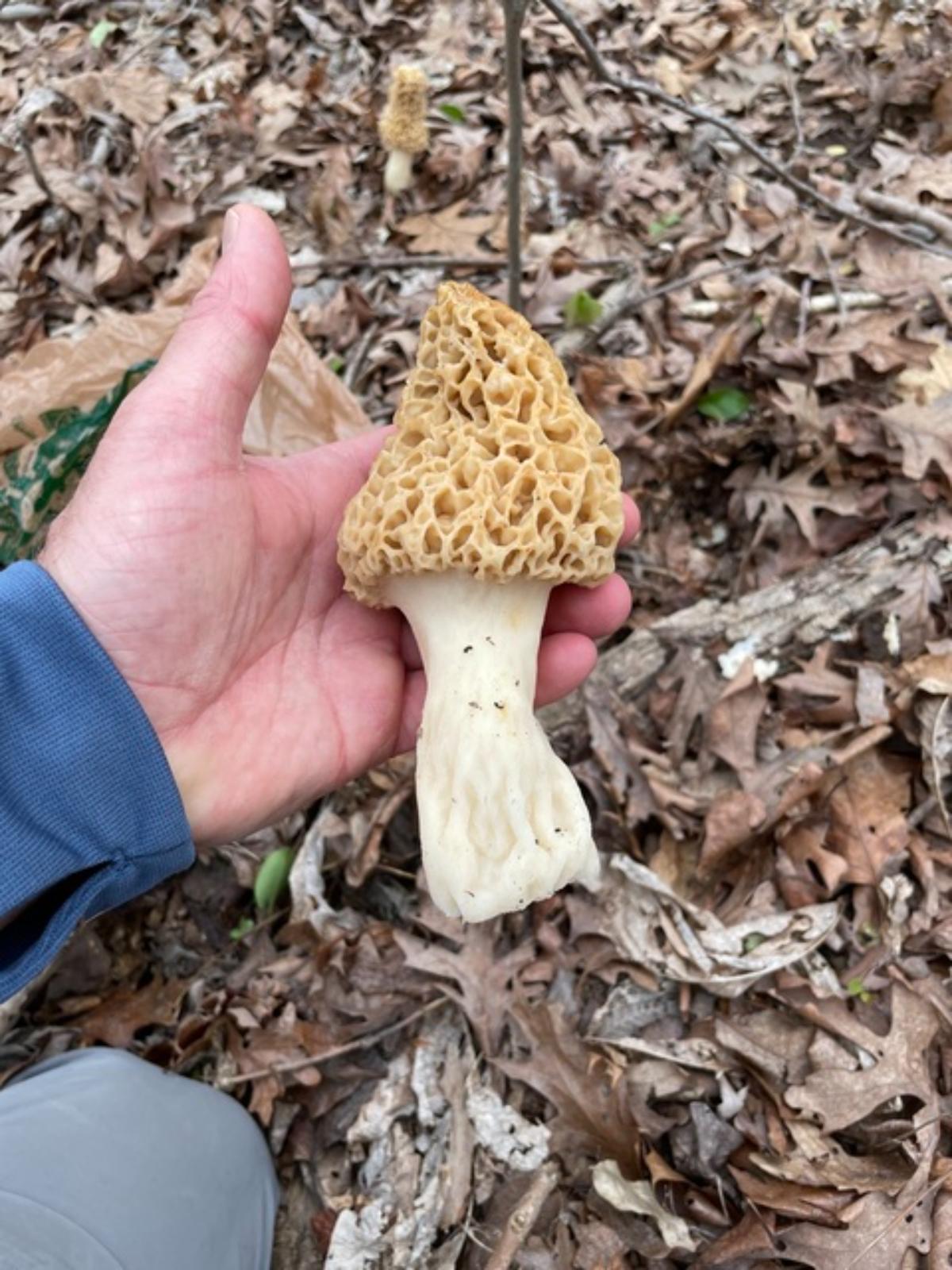
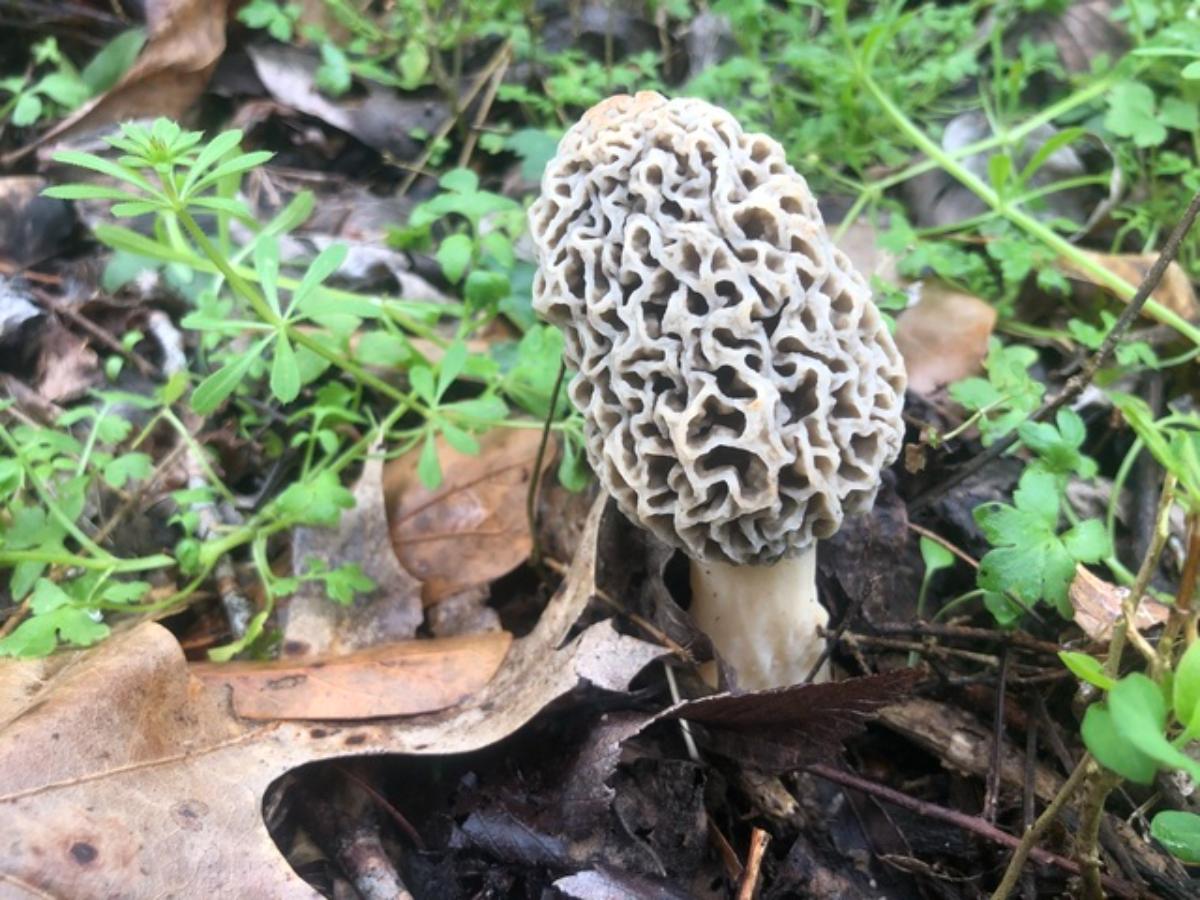
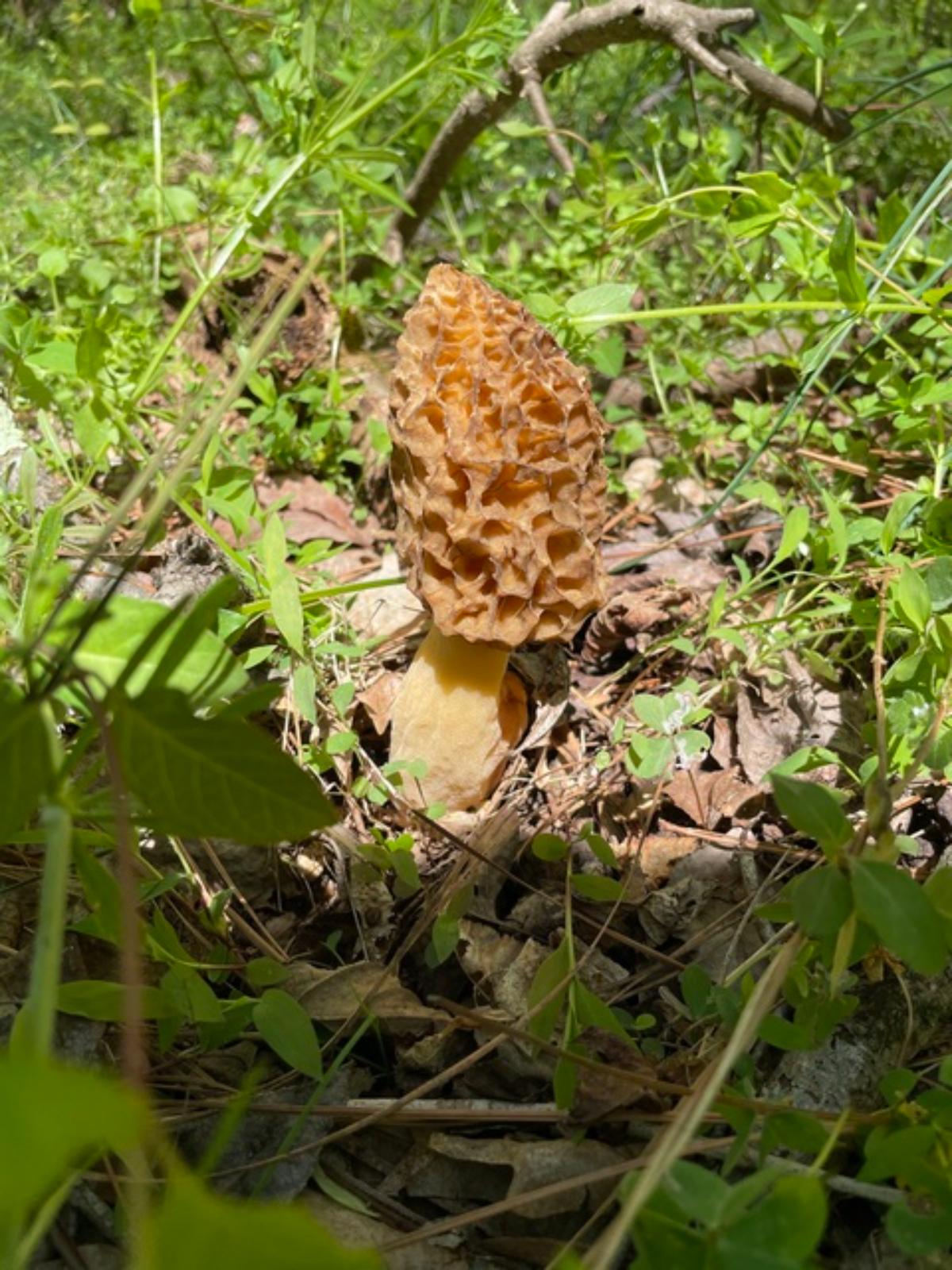
Morchella prava
This yellow species of morel grows in many of the northern states and is not separated by east or west like all the other morels.
- Region: Northern US and southern Canada, from Montana to Ontario.
- Season: April-June
- Habitat: Hardwoods and conifers, preferring sandy soil around bodies of water, like rivers and lakes. May have a preference for oaks and pines.
- Size: Stem – 1-1 ½ inch tall; Cap – 1 ¼ – 2 ¼ inches long.
- Description: Ridges and pits are randomly arranged. The ridges are light yellow or white when young, and the pits are dark gray or black. As it ages, the ridges turn yellowish-brown, as do the pits. This yellow morel often stays in the immature stage for an extended period and retains its gray pits. The stem base is slightly swollen.
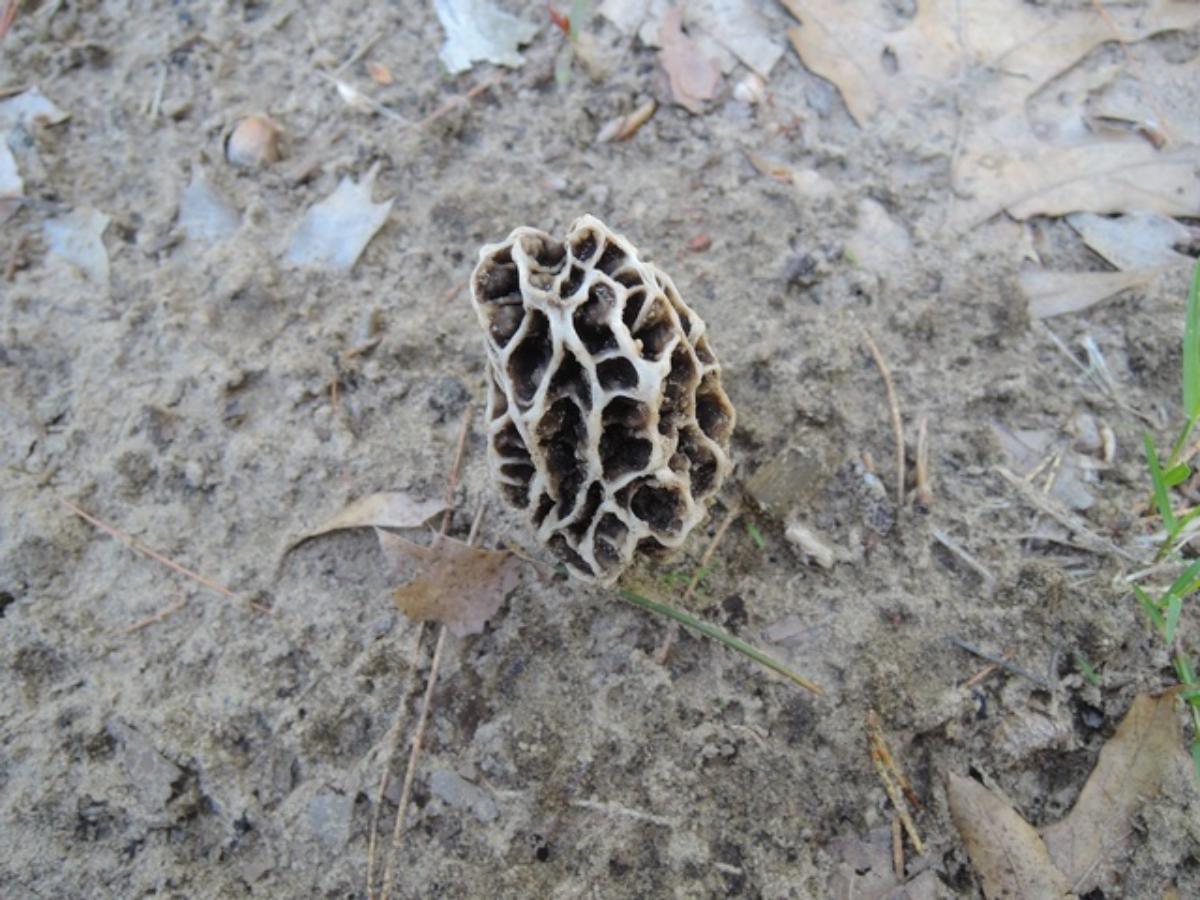
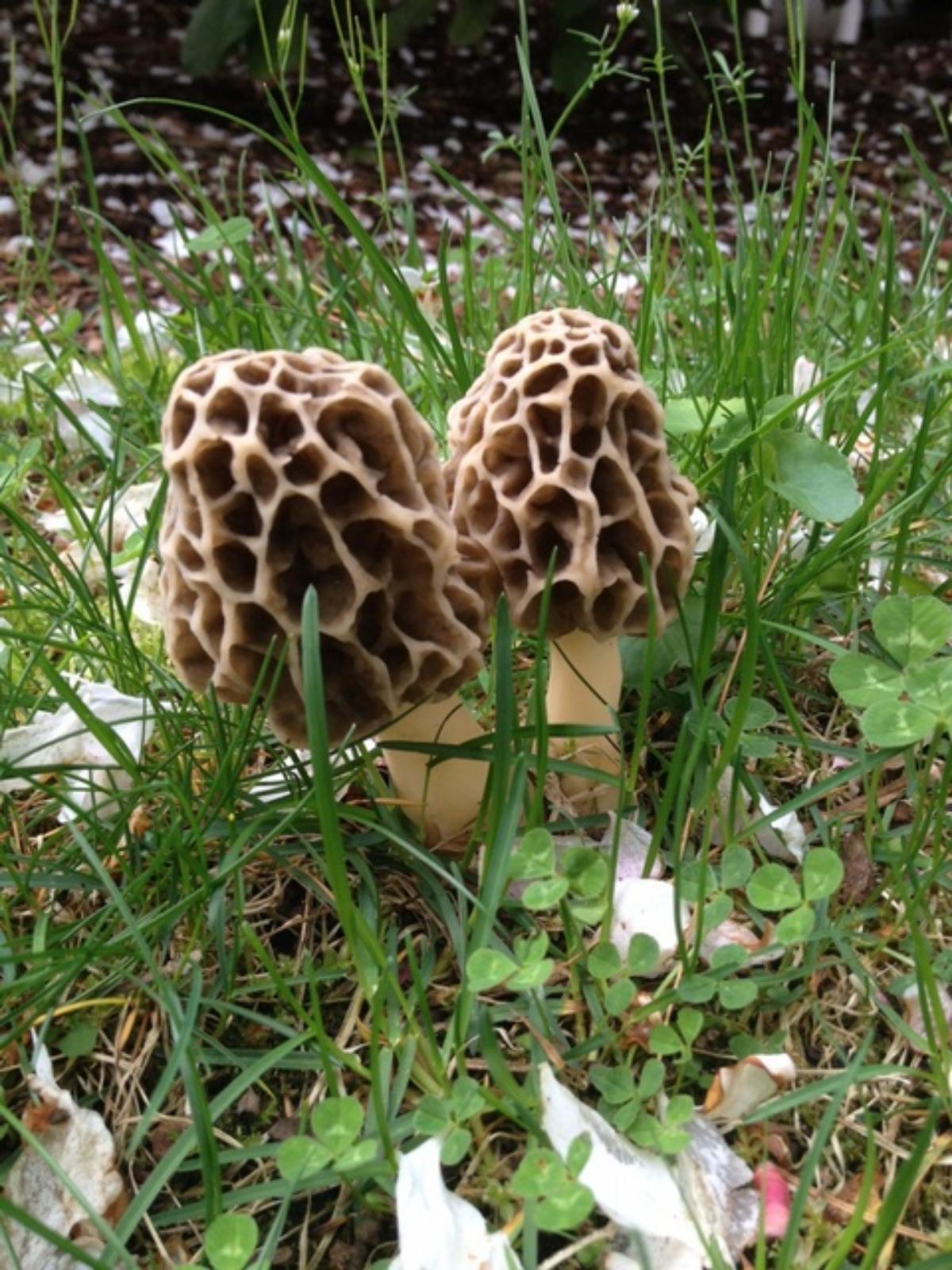
Eastern Morels
The Three East Coast Black Morels
Morchella angusticeps
This is the standard, classic, black morel. It is the only black morel in most places, making it easy to identify.
- Region: East of the Rocky Mountains; prolific
- Season: March-May
- Habitat: Hardwood trees – ash, apple, cherry, and tulip
- Size: Stem – ¾-3 inches tall; Cap – 1-3 inches high and ¾-2 inches wide.
- Description: Deep vertical pits and ridges, tan or brownish-yellow when young, dark brown to black with age.
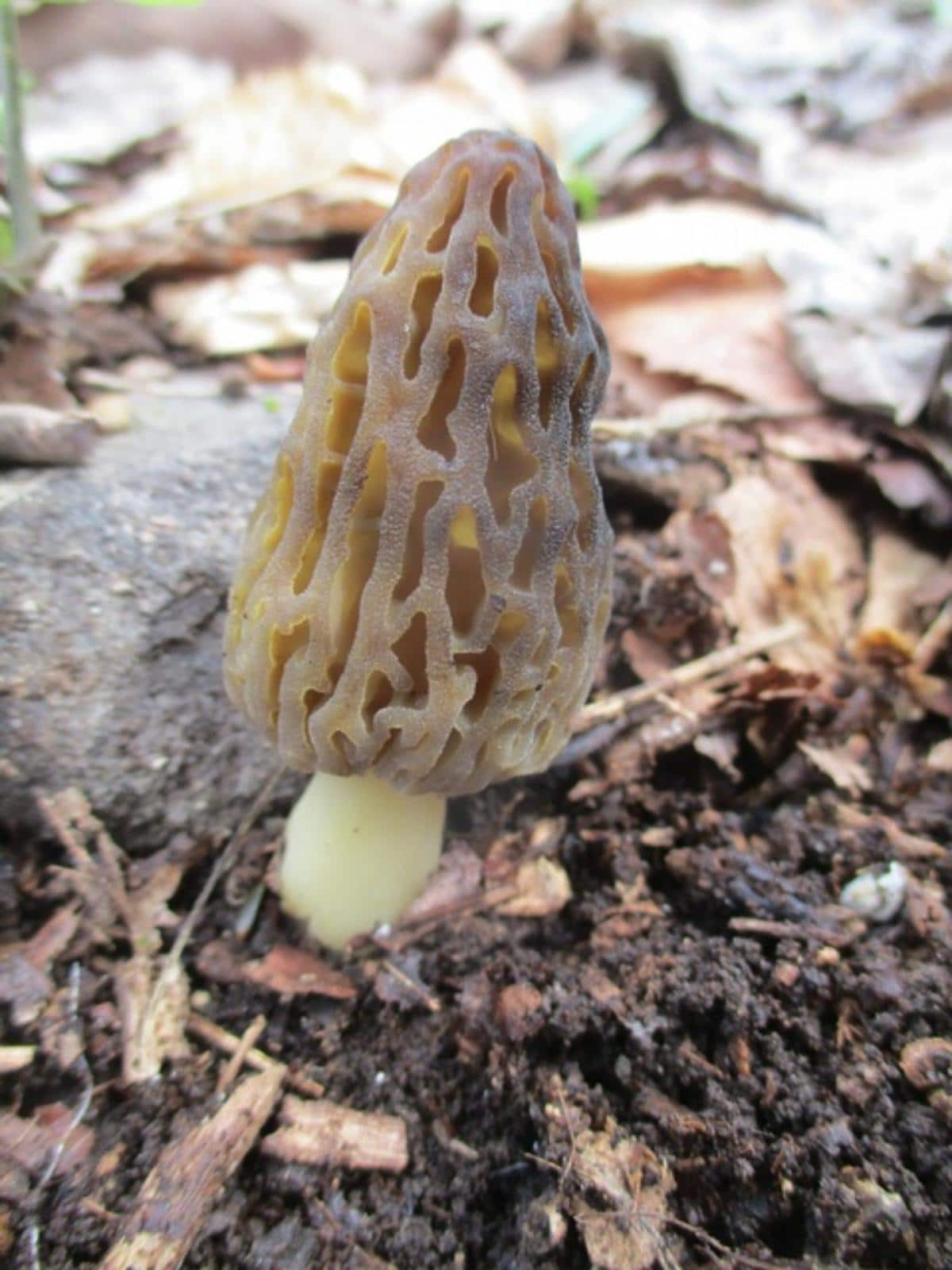
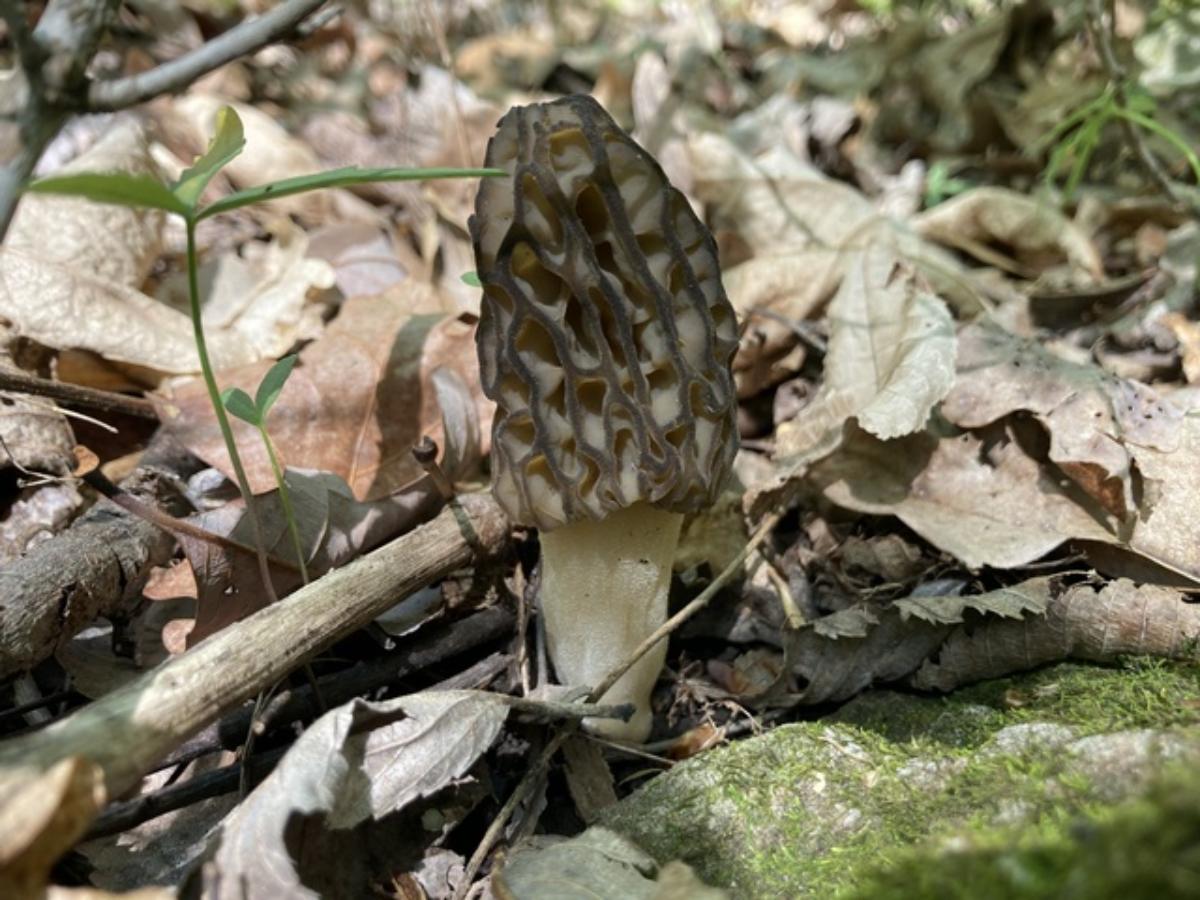
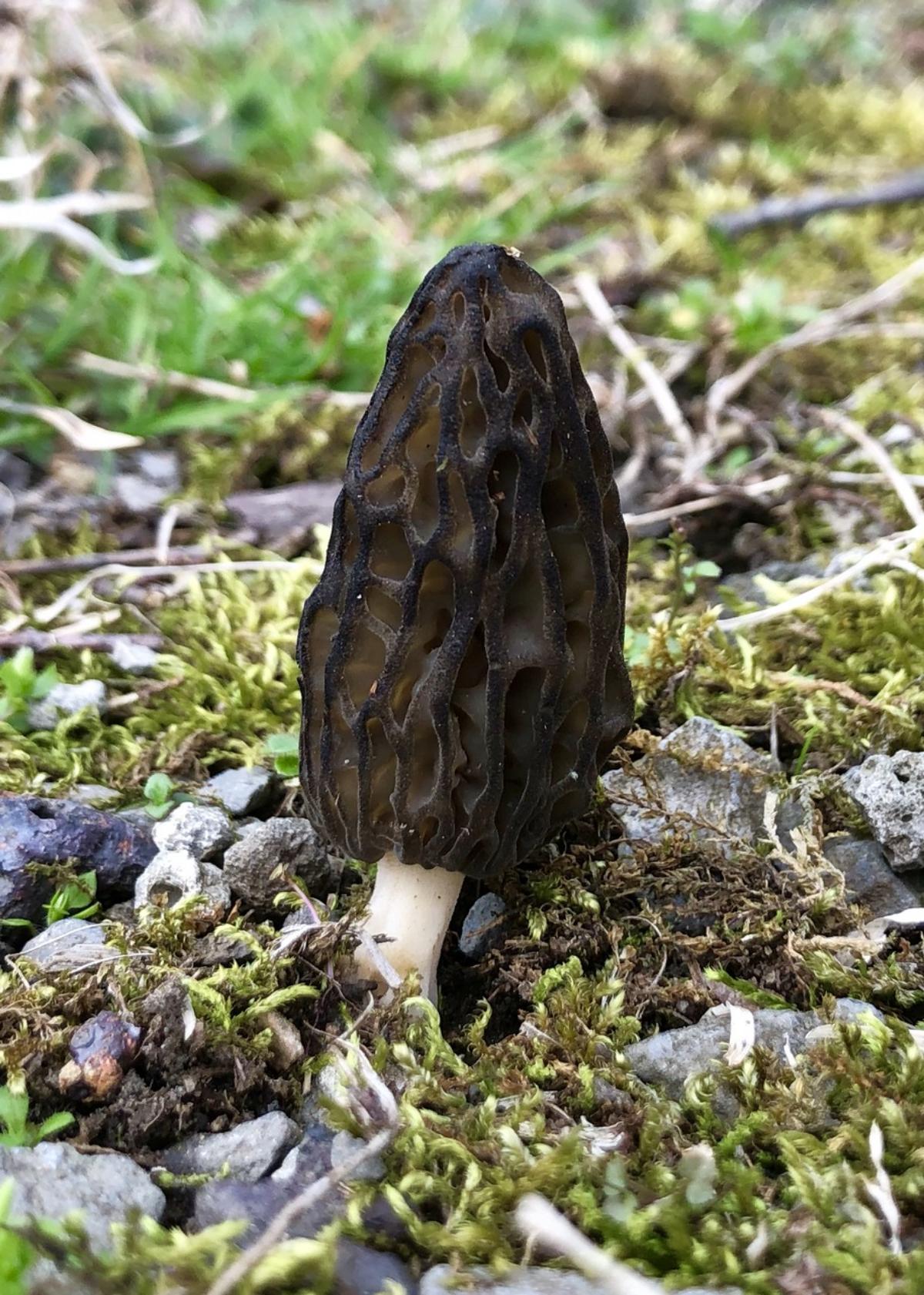
Morchella septentrionalis
- Region: North from the 45th parallel, including northern Michigan, northern New York, and possibly northern New England.
- Season: May
- Habitat: Hardwoods – ash and big-toothed aspen. May grow from rotting hardwood.
- Size: Stem – ¾ -1 ¼ inches tall; Cap – 1- 1 ¾ inches high.
- Description: Almost identical to M. angusticeps, especially when young. Distinguishable by smaller size and unusual habit of growing out of decaying wood.
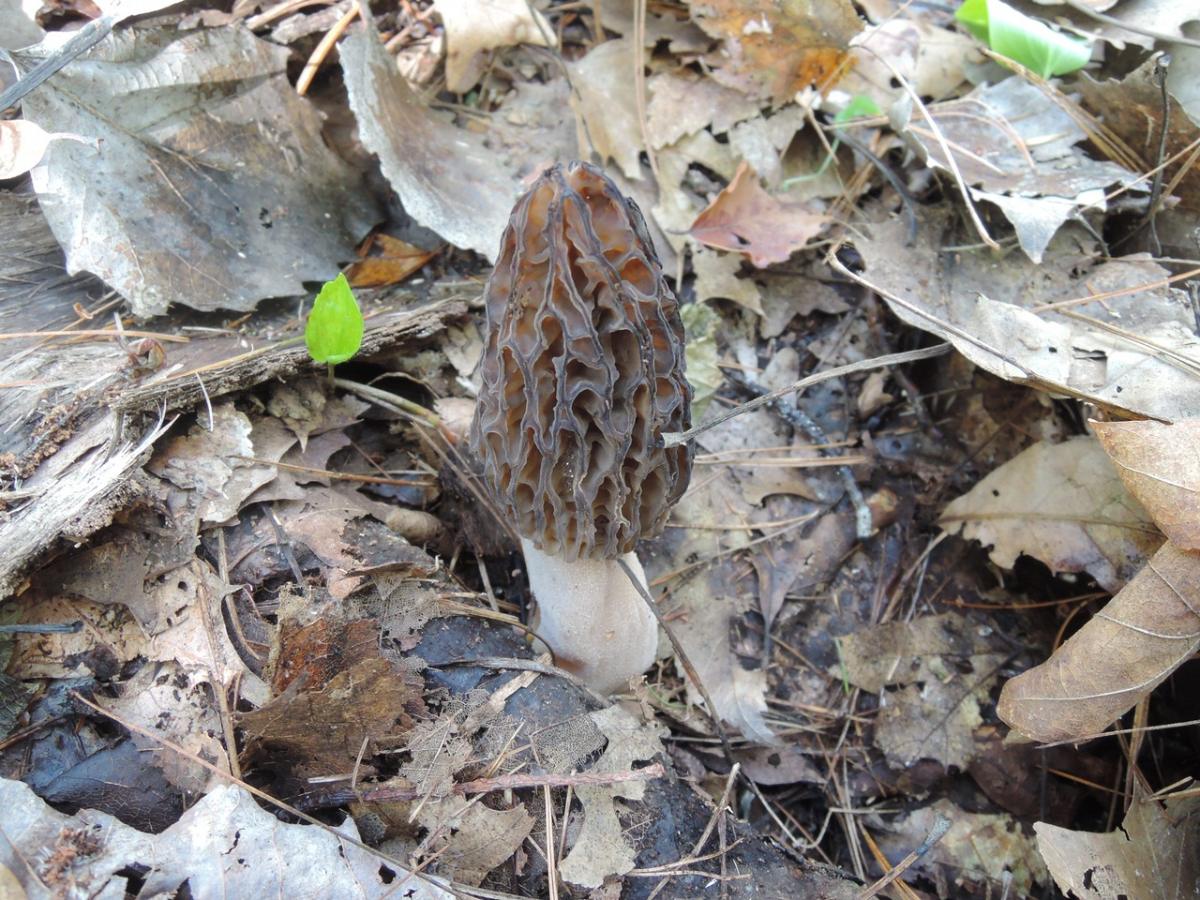
Morchella punctipes
A type of morel called a half-free morel.
- Region: East of the Great Plains.
- Season: March-May
- Habitat: Hardwoods
- Size: Stem – ½ – 6 inches tall; Cap – ¾ – 1 ¾ inch high.
- Description: Half-free morel; cap is attached to the stem halfway down, causing the cap to dangle around the stem. Dark vertical ridges, yellowish-brown pits. Often quite tall – the stem is long, but the cap is short, like a little beanie cap. Indistinguishable from M.populiphila except by which side of the Rockies they’re on.
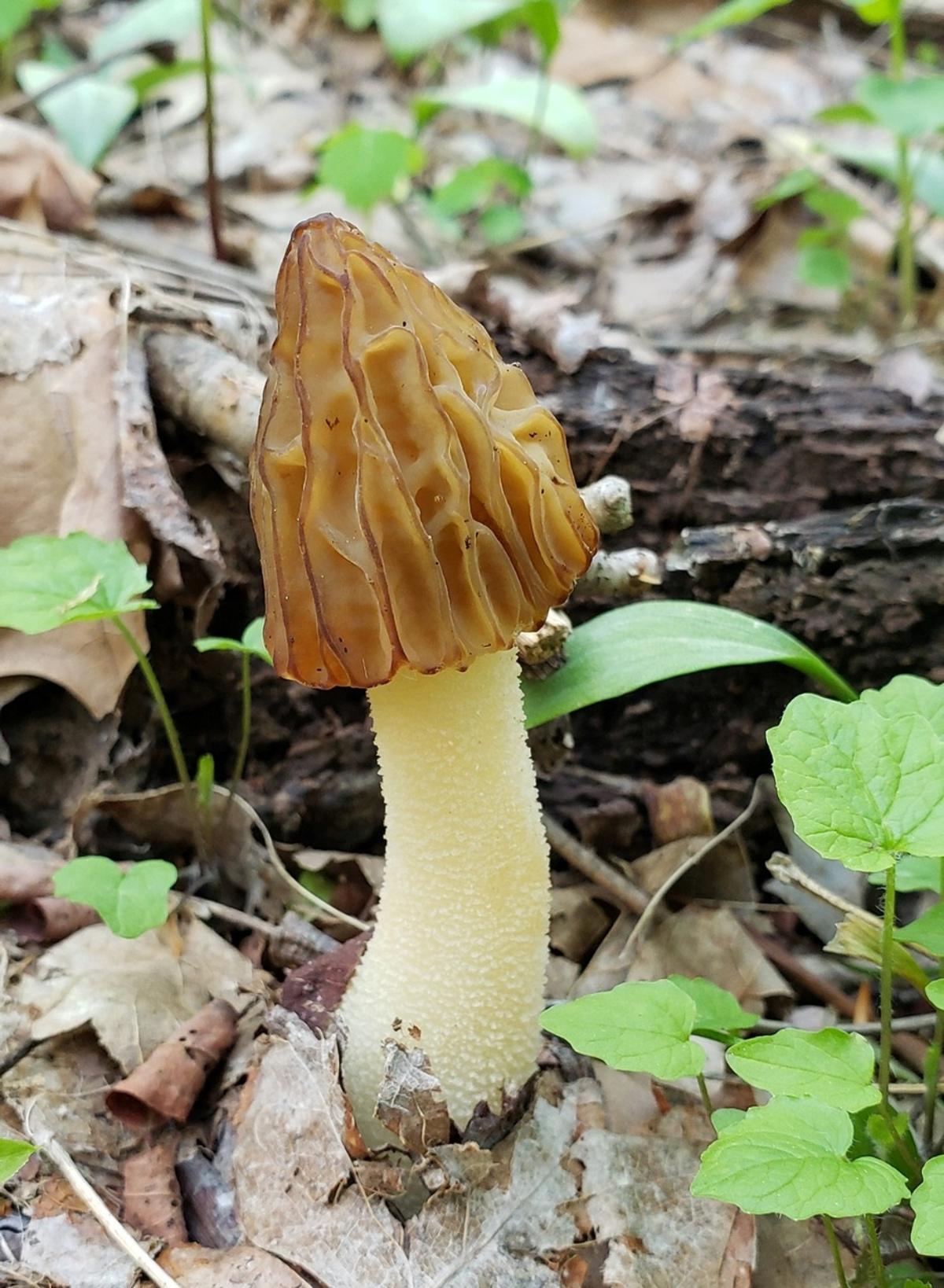
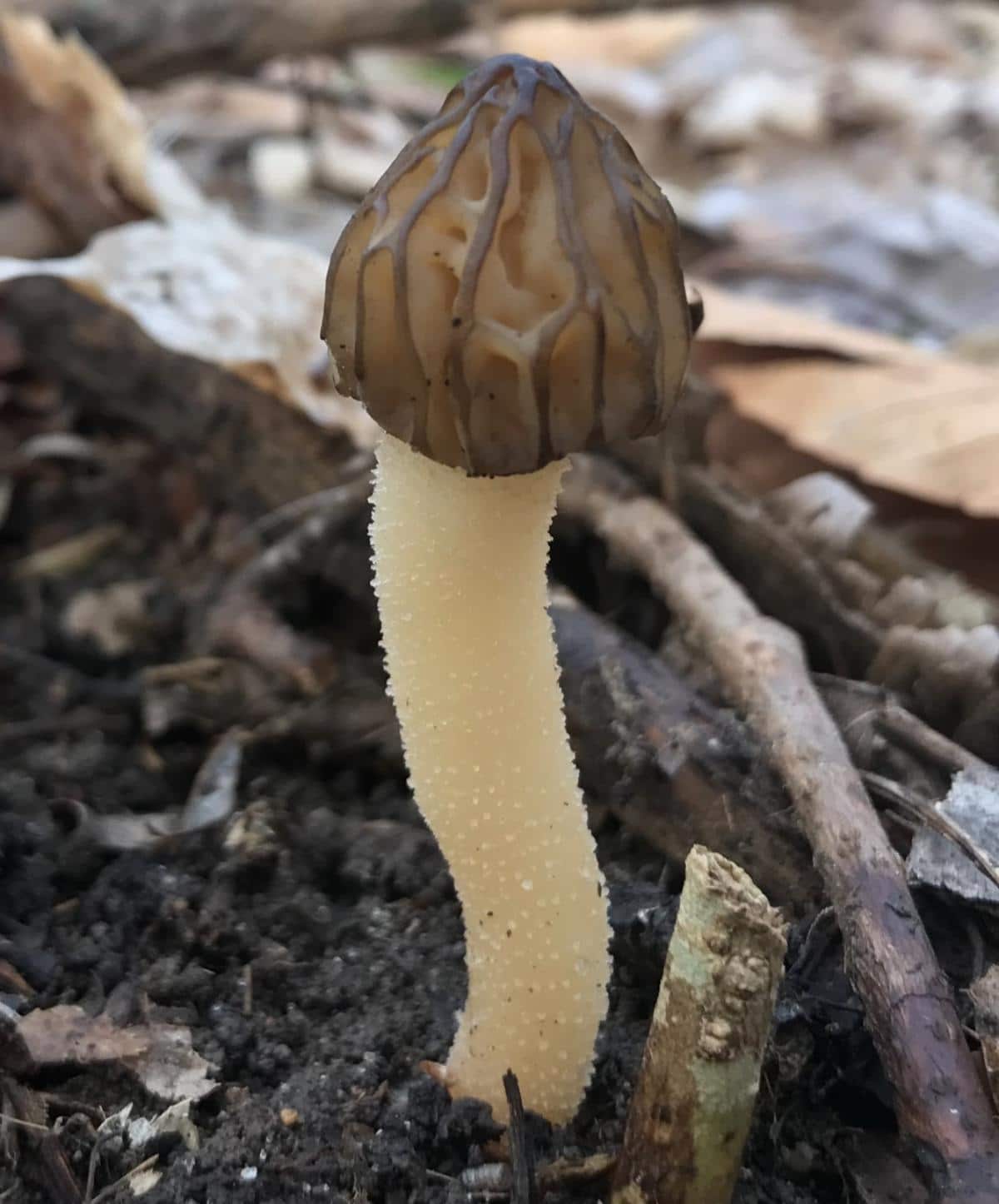
The Three East Coast Yellow Morels
Morchella cryptica
- Region: Around the Great Lakes, from central Illinois up to Ontario and down to western Pennsylvania.
- Season: April-June
- Habitat: Hardwoods, specifically ash, apple, and tulip
- Size: Stem – 2 – 5 ¼ inches tall; Cap – 1 ½ – 3 ¼ inches long.
- Description: Egg-shaped or rounded cap. Randomly formed ridges white to pale yellow when young with gray to dark brown pits. In maturity, ridges turn yellowish-brown, as do the pits. Often called a gray morel because of its appearance when young. The stem is swollen at the base. Commonly grows alongside M. americana; almost impossible to tell the two apart.
Morchella diminutiva
This morel gets its name appropriately from its small size compared to other yellow morels.
- Region: East of the Great Plains and south of the Great Lakes
- Season: April – May
- Habitat: Hardwoods, preferring green ash, white ash, hickory, and tulip trees.
- Size: Stem – ¼ – 2 ¾ inches long; Cap – ¾ – 1 ½ inch long.
- Description: Ridges are yellowish when young, and the pits are dark gray. As it matures, the ridges become brownish-yellow, and so do the pits. The cap to stem ratio on this little morel is off-balance, with the stem being significantly longer. This is a unique feature among the yellow morels. M. diminutiva also has vertically aligned ridges and pits, which are usually only found in black morels.
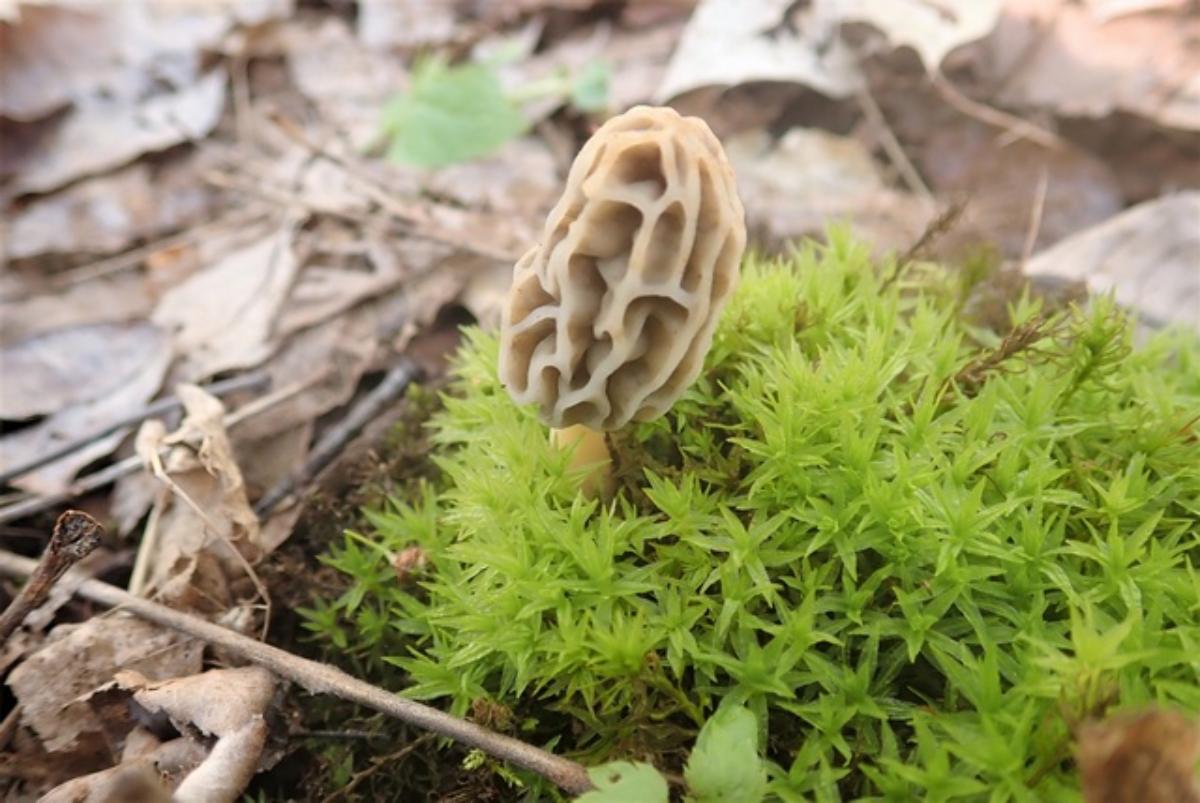
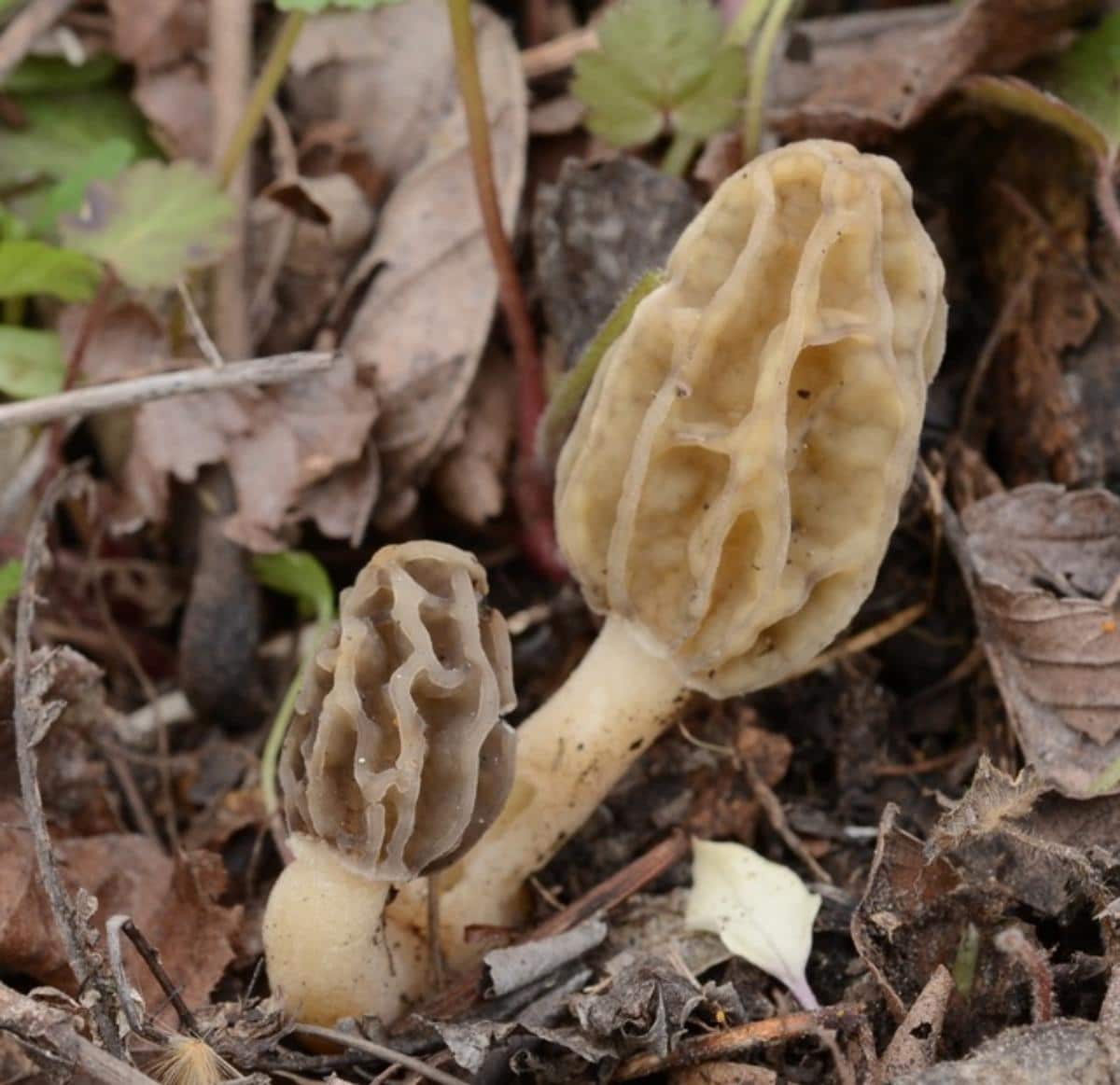
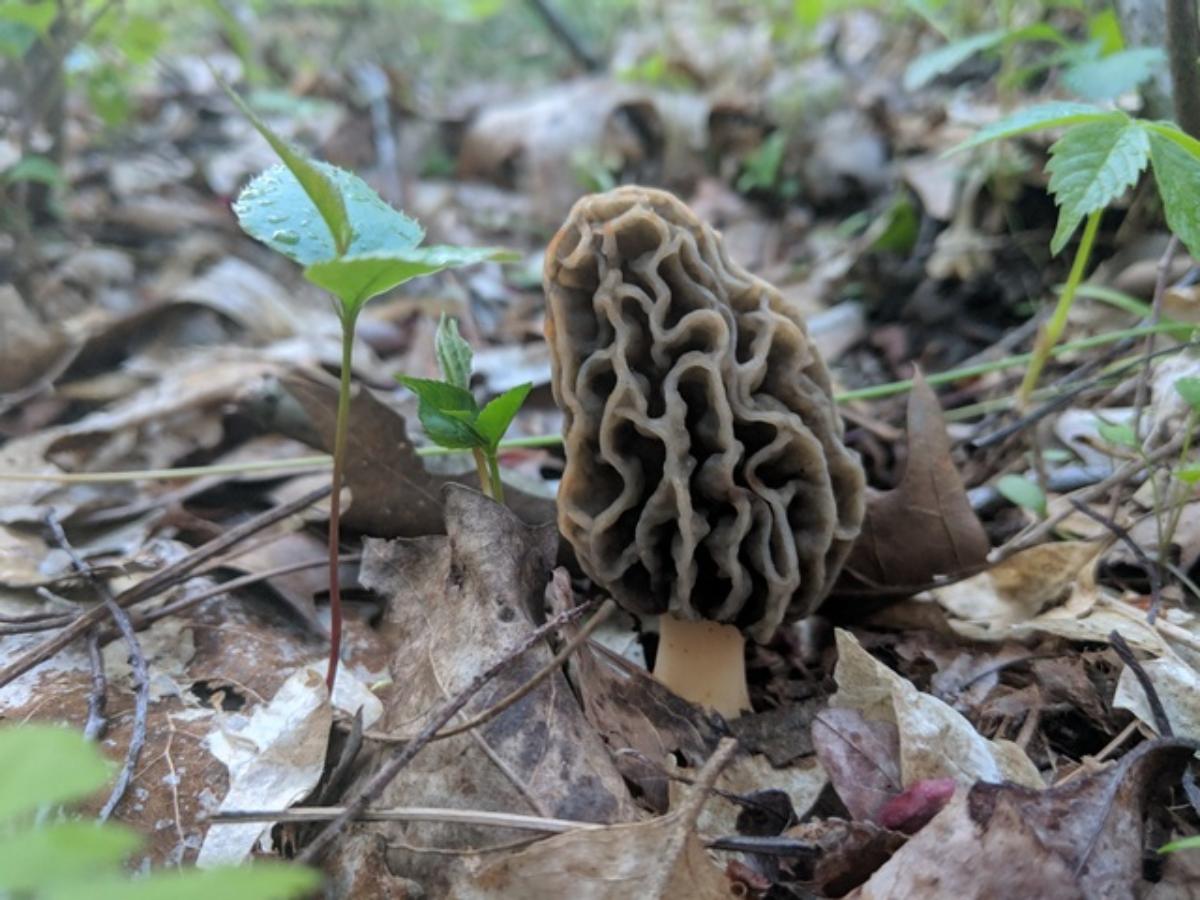
Morchella virginiana
- Region: Southeastern North America
- Season: April – May
- Habitat: Tulip trees, with a preference for riverbeds, sandy soil, and coastal areas.
- Size: Stem – 1- 2 ¼ inches long; Cap – 1 – 2 ¾ inches tall.
- Description: When young, the ridges are yellow with gray pits. As it matures, the ridges turn brownish-yellow with the same gray pits. The stem is slightly swollen at the base.
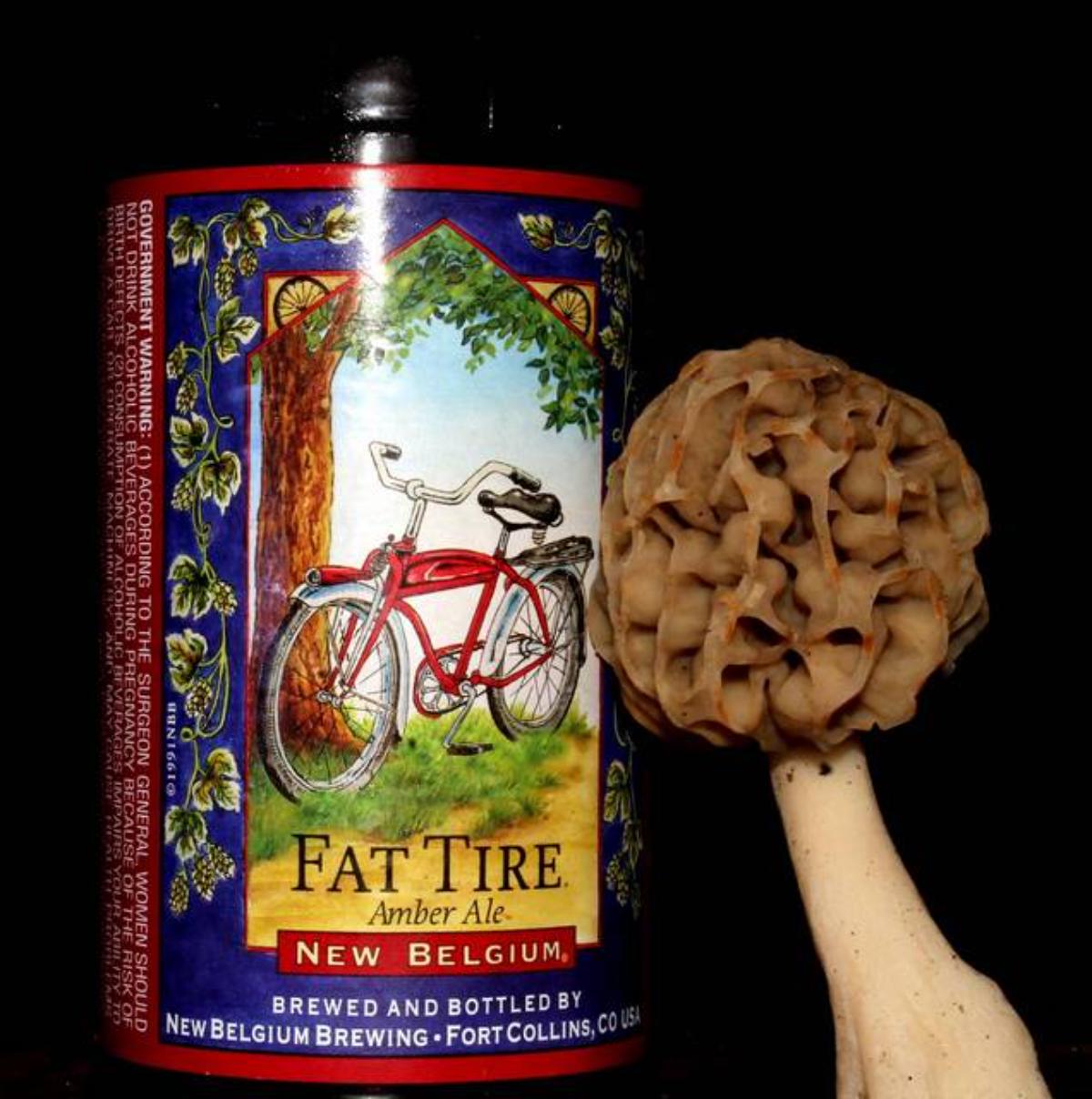
Western Morels
Morchella brunnea
This is the standard, classic, west coast black morel.
- Region: Oregon, possibly across western North America
- Season: March-May
- Habitat: Hardwoods, including oak and Pacific madrone. Sometimes conifers.
- Size: Stem – ¾ – 2 inches tall; Cap – 1-2 inches tall.
- Description: The twin to the classic east coast black morel, M. angusticepes. Dark brown or black vertical ridges with yellowish-brown pits.
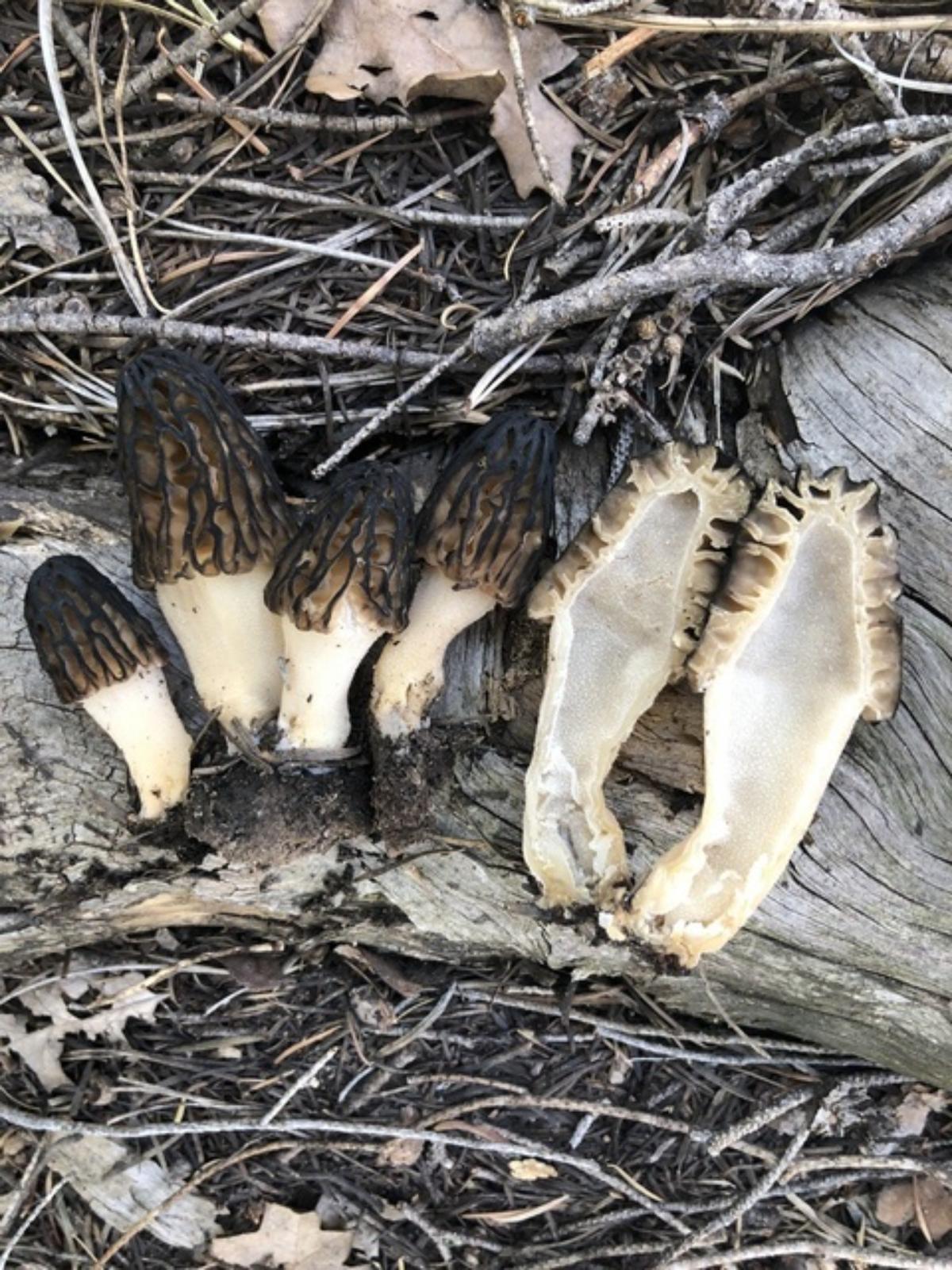
Morchella importuna
This morel gets its name from the fact that it is an opportunistic morel. This is the prime morel species used in cultivation since its habitat is easier to replicate.
- Region: West Coast, specifically California and Nevada. Likely spreading.
- Season: March-May
- Habitat: Disturbed ground, including landscaping sites (mulch!), planters, gardens, parks
- Size: Stem – 1-4 inches tall; Cap – 1-6 inches long.
- Description: This is a very unique and special morel. It doesn’t grow with trees like the other morels. Instead, this one is opportunistic (hence the common name). In addition to growing differently than other species, the opportune morel is gigantic.
Swollen base, deep vertical and horizontal ridges that give it a ladder-like appearance. Ridges are gray or brown with matching pits when young. Matures to dark brown or black ridges and yellowish-brown pits.
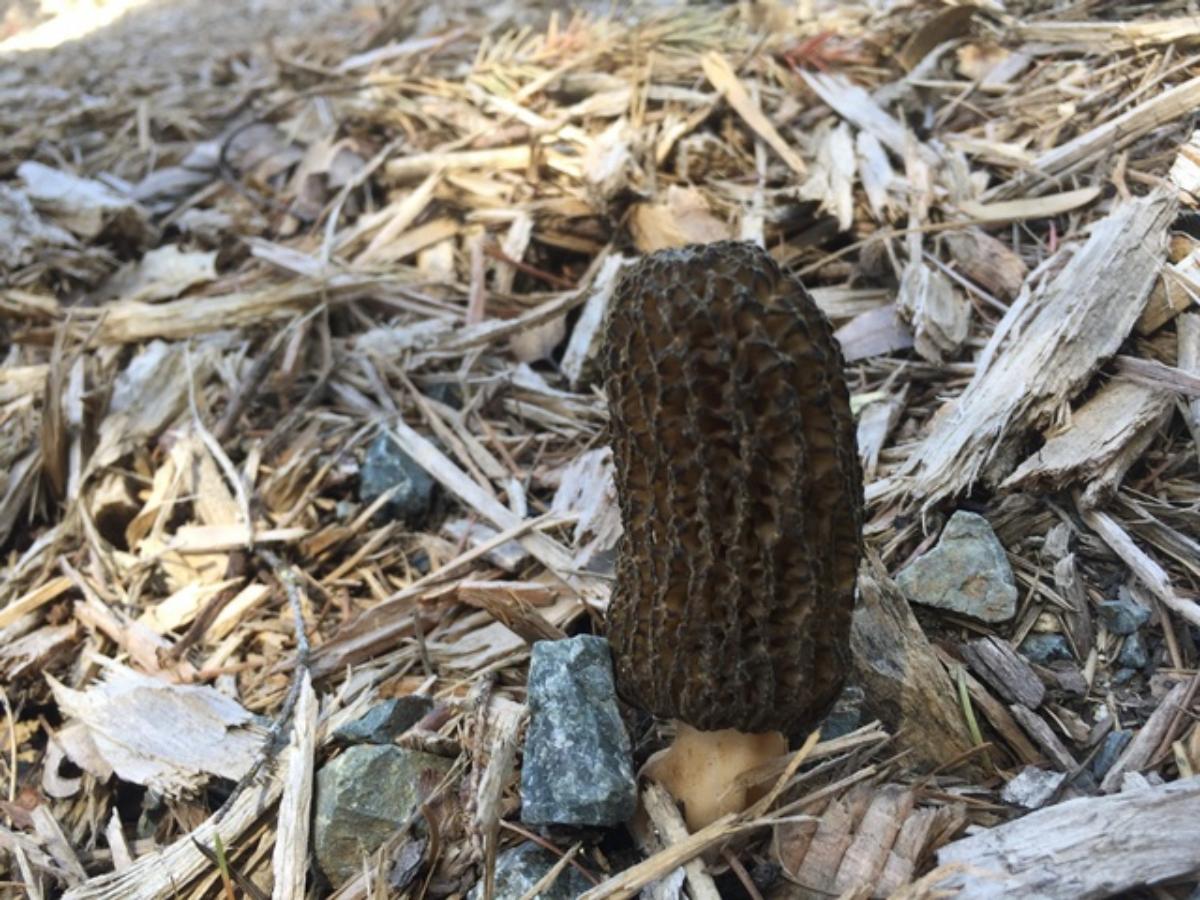
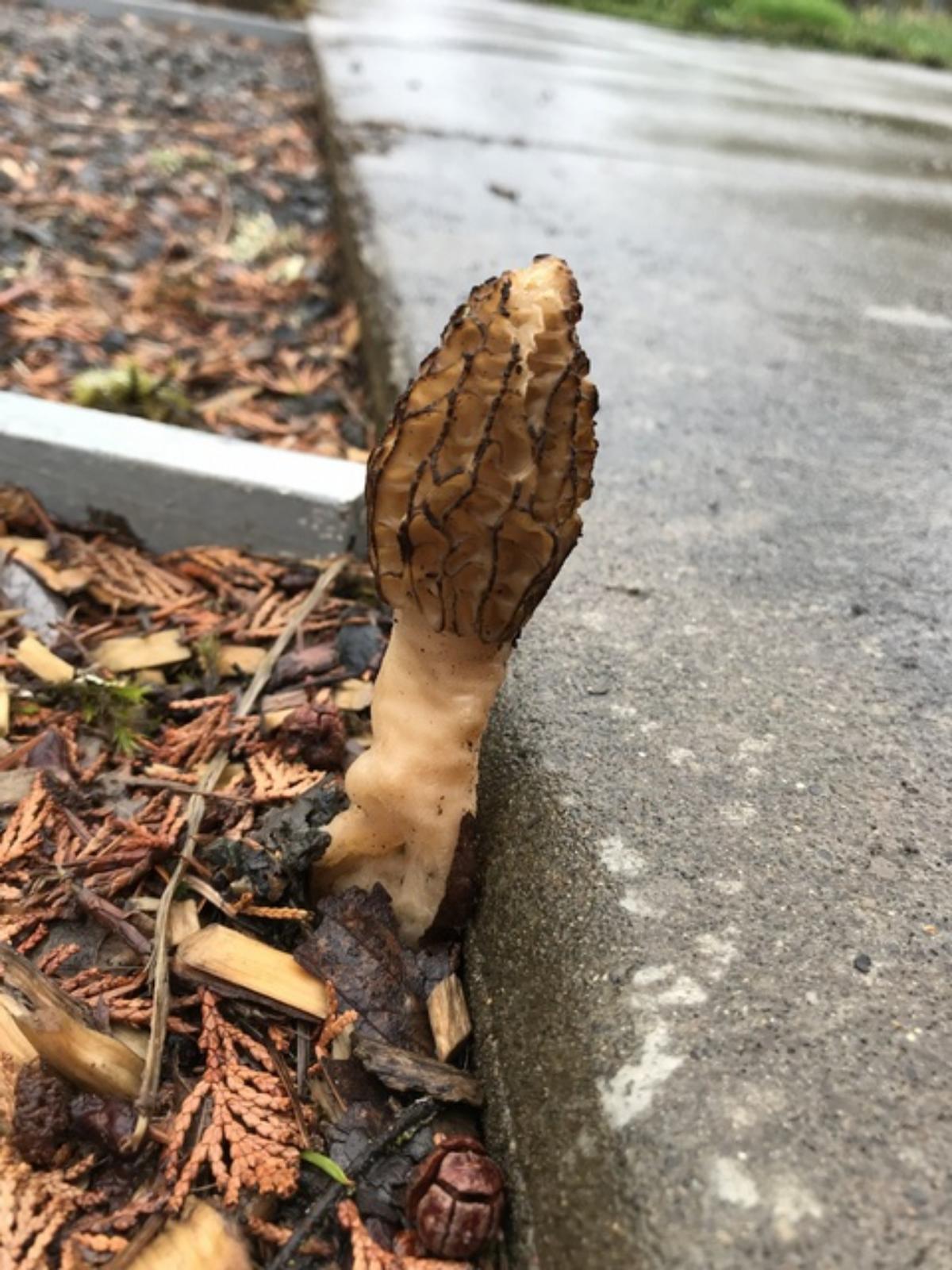
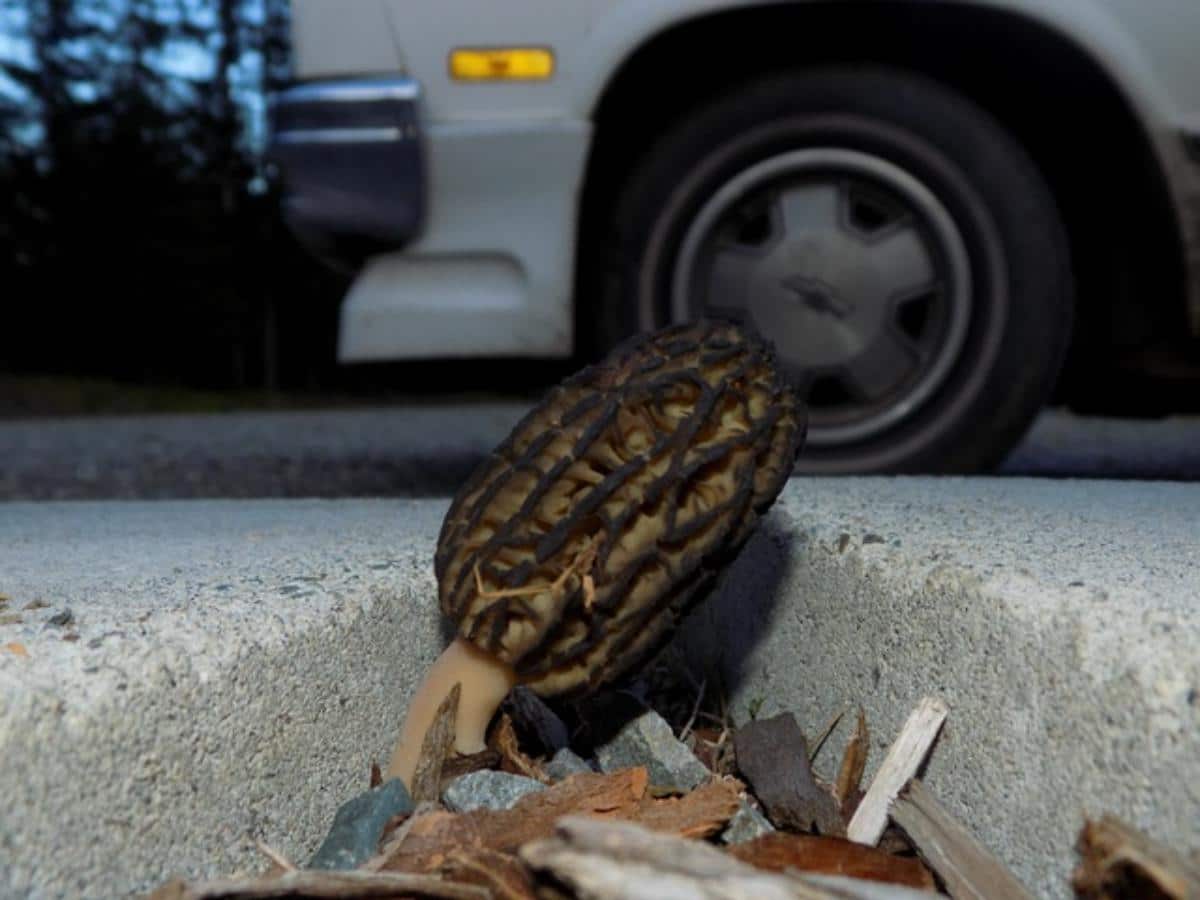
Morchella snyderi
A fun morel and quite distinguishable from other black morels.
- Region: Western North America (California, Oregon, Washington, Idaho, Montana)
- Season: April – June
- Habitat: Conifers, specifically ponderosa pine, white fir, and Douglas fir
- Size: Stem – 1 ¼ – 2 ¾ inches tall; Cap – 1- 2 ¼ inches long
- Description: Often mistaken for a yellow morel because immature specimens feature yellow ridges. As it ages, ridges turn dark brown to black. Not uncommon to find M.snyderi halfway through its’ color transition with a cap that is half yellow and half black. Distinguishing feature is a pockmarked stem.
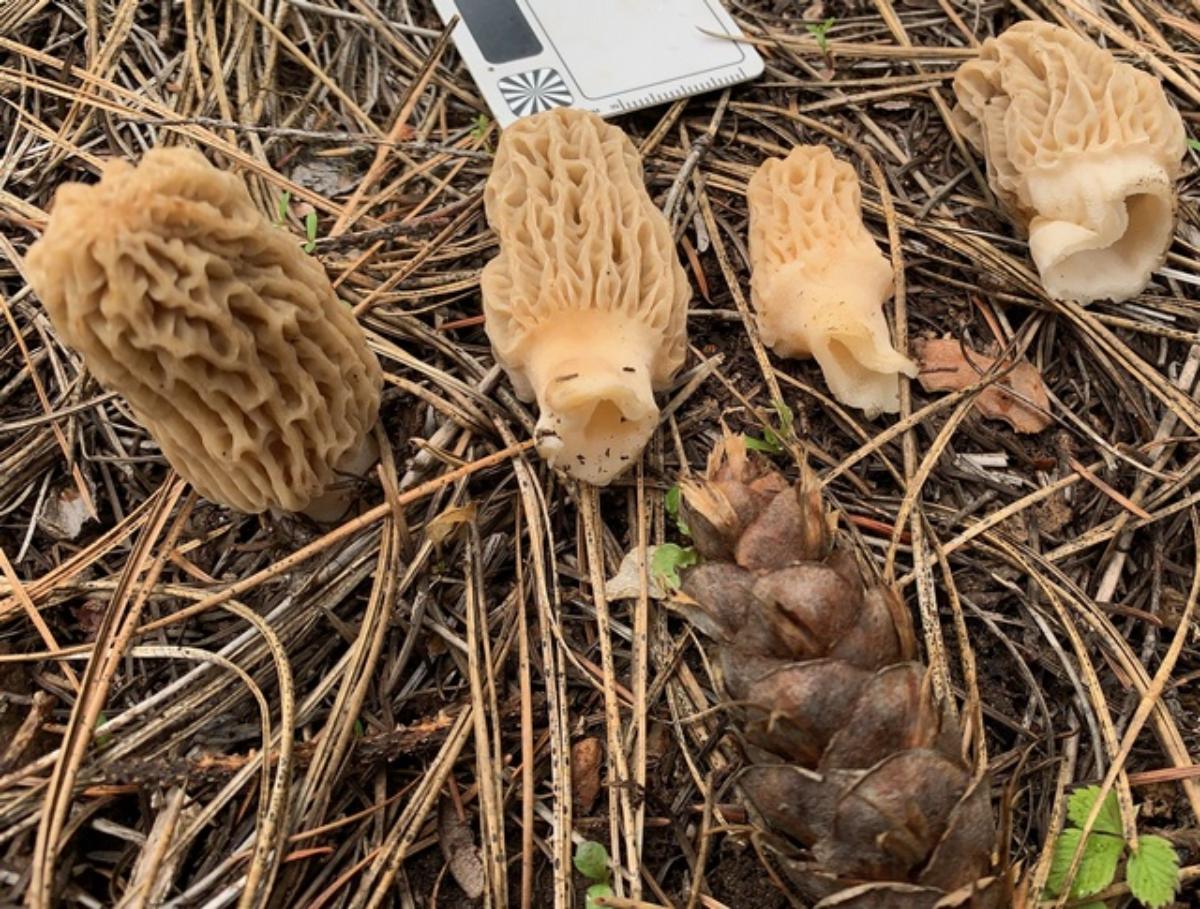
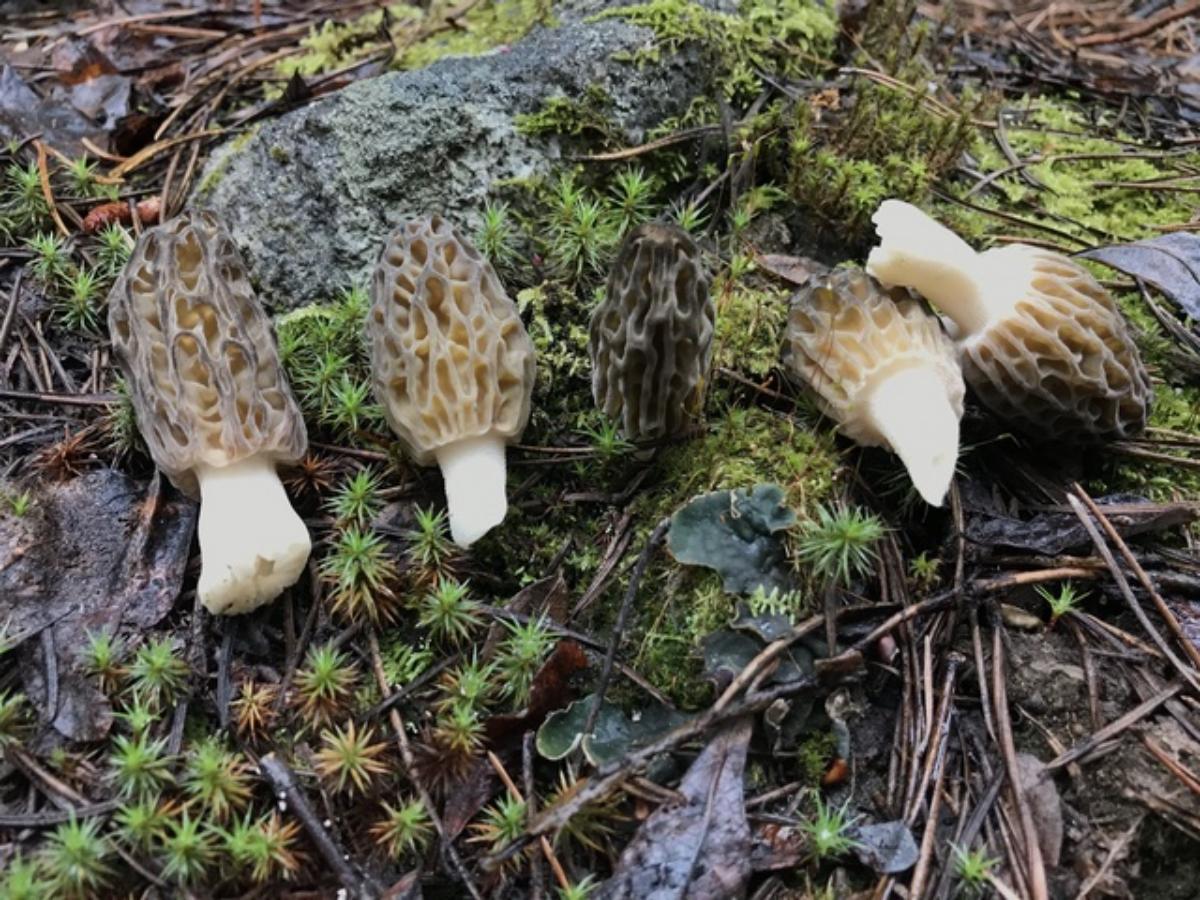
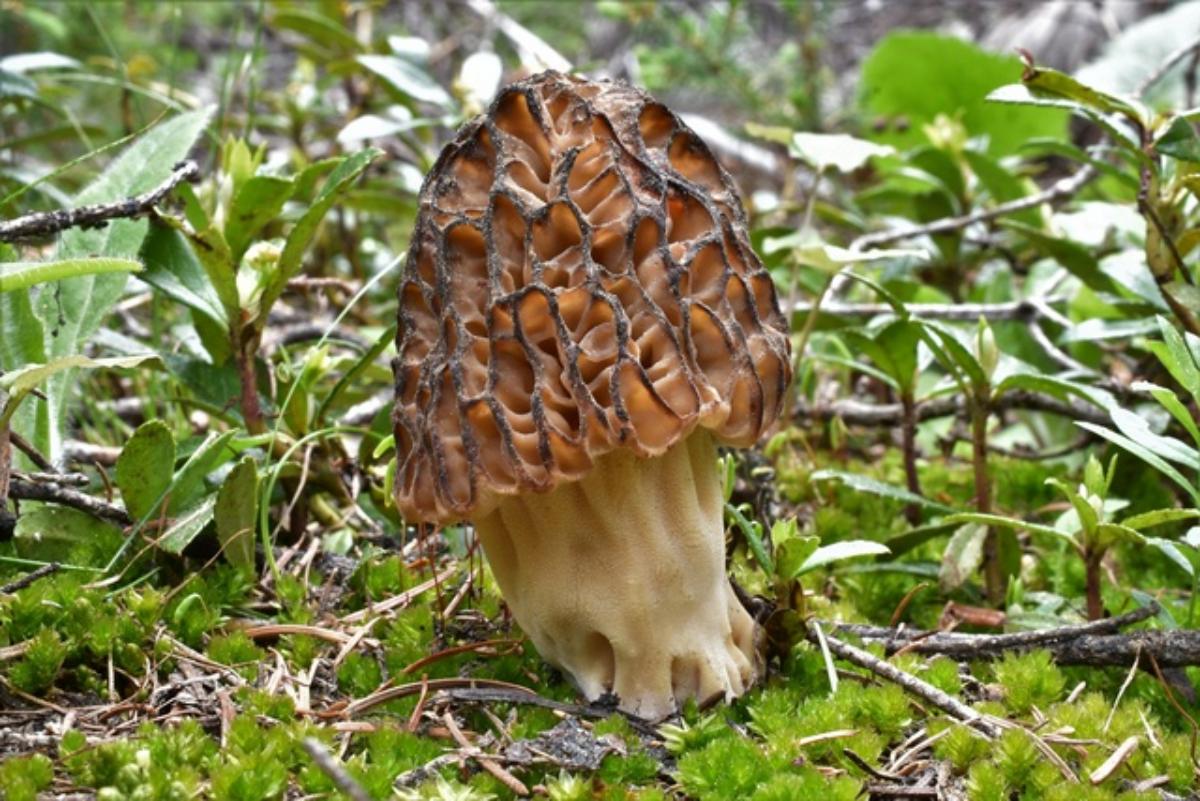
Morchella frustrata
Another morel that is aptly named.
- Region: Western North America
- Season: April – May
- Habitat: Hardwoods or conifers, preferring Pacific madrone, oaks, ponderosa pine, sugar pine, white fir, and Douglas fir.
- Size: Stem – ¾ – 1 ½ inch long; Cap – 1 ½ – 2 ¼ inches tall.
- Description: Aptly named frustrating black morel that remains yellow most of its’ life. DNA and vertical-orientated ridges place it firmly in the black morel clade. The ridges darken with maturity but still aren’t as dark as most black morels. The stem is very pockmarked.
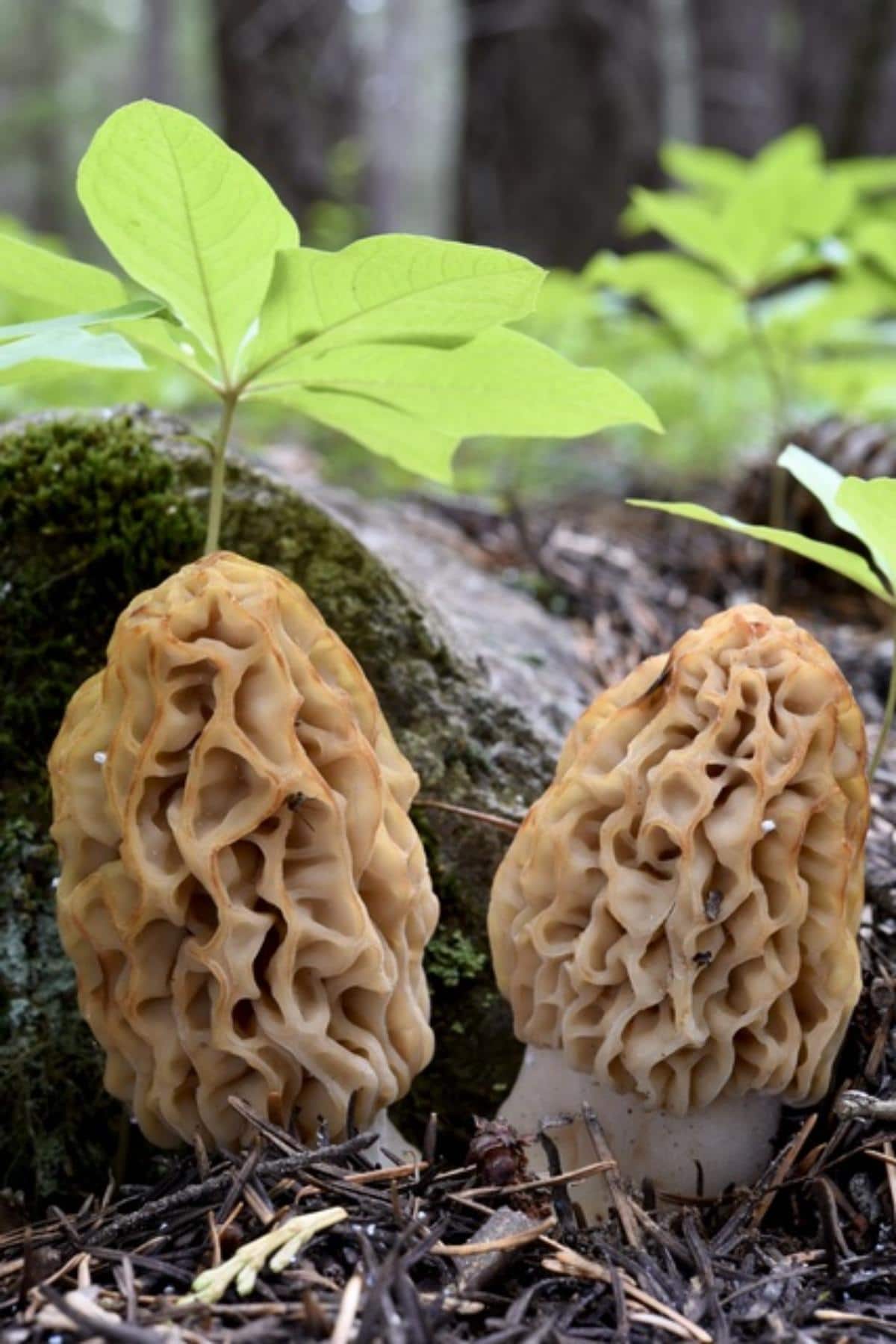
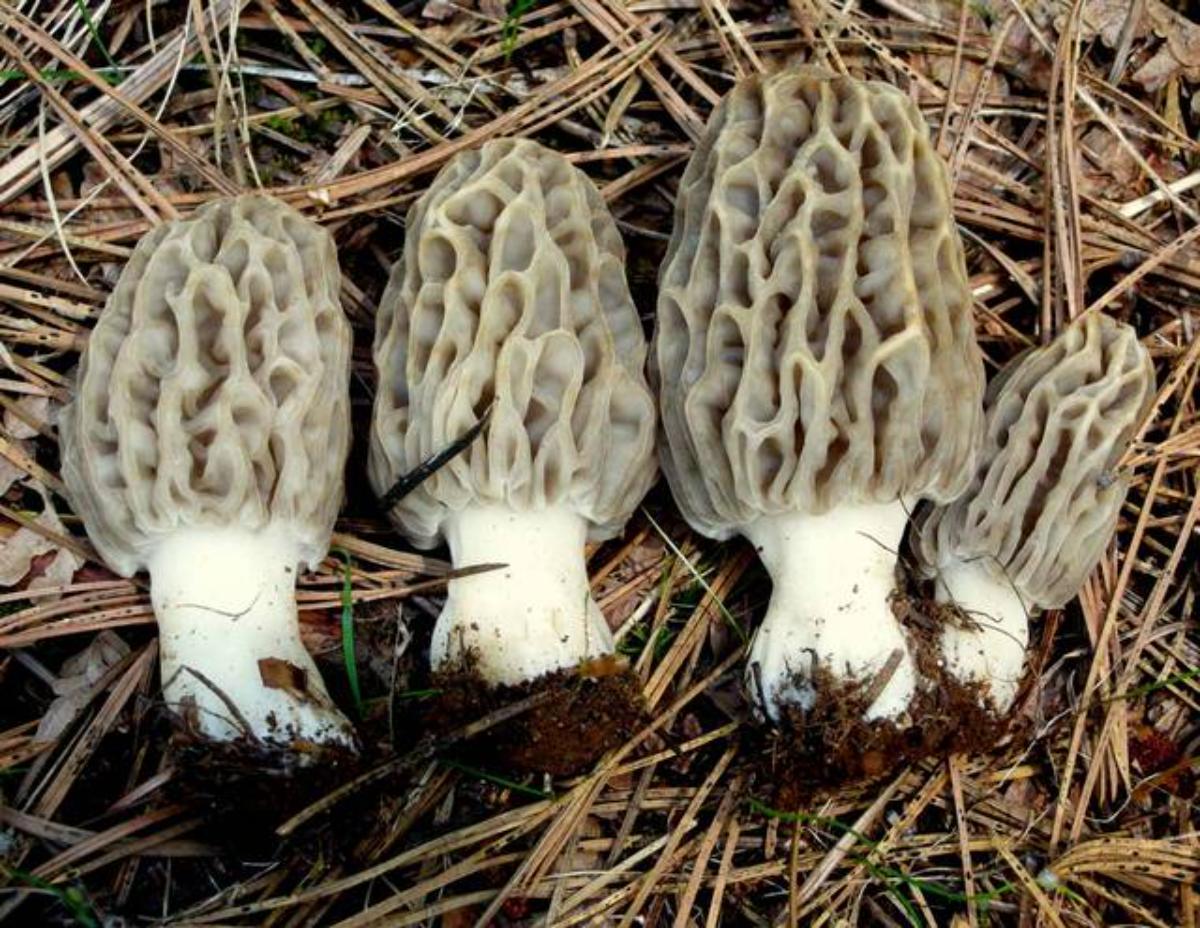
Morchella populiphila
The west coast version of M.punctipes half-free morel.
- Region: northwestern North America
- Season: March-May
- Habitat: Black cottonwood in river bottoms
- Size: Stem – ¾ – 4 ¼ inches long; Cap – ¾ – 2 inches tall.
- Description: Half-free morel; the cap is attached halfway down the stem, which gives it a dangling look. Cap is significantly smaller than the elongated stem. Cap looks like a little beanie. When young, ridges and pits are light brown. Ridges turn dark brown to black with maturity, and pits become yellowish-brown. The stem base is usually swollen.
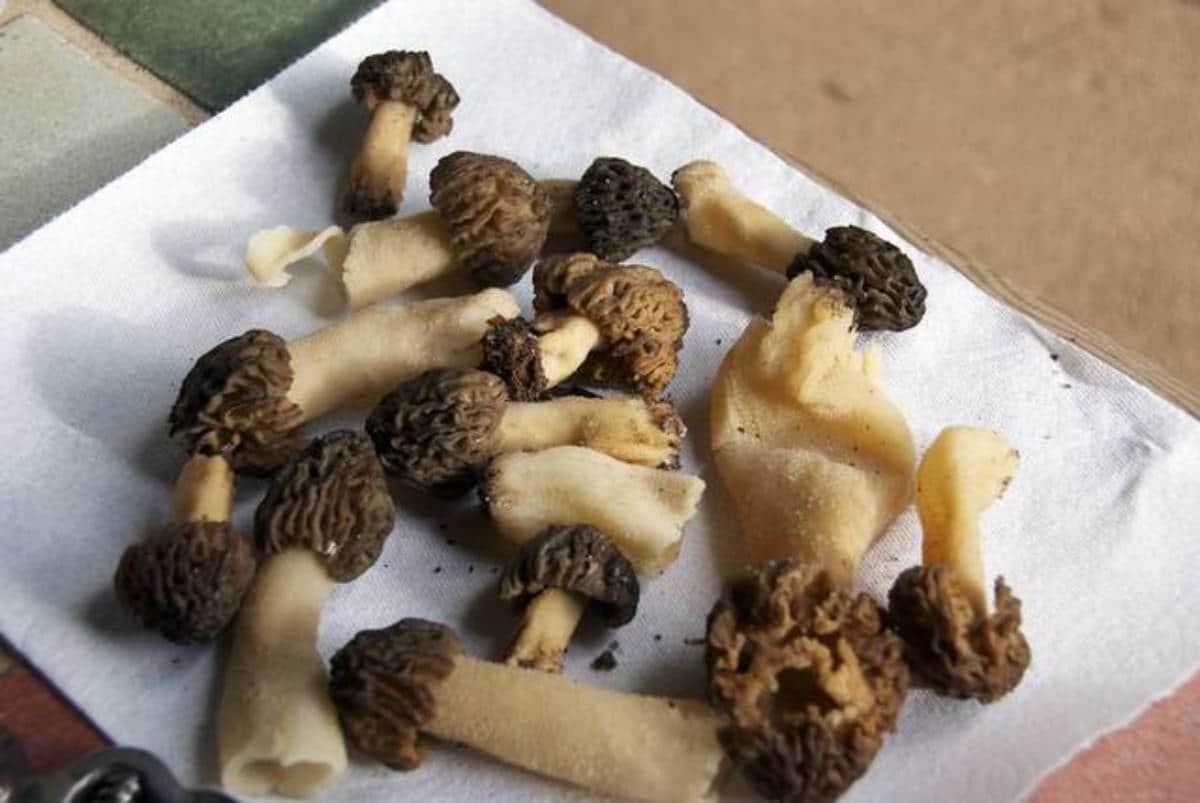
West Coast Burn-Site Black Morels
The last four types of west coast morels are called burn-site morels because they grow exclusively in burned conifer forests. They grow in the spring following a fire and sometimes for a couple of years afterward as well. However, in later years, they appear in fewer and fewer quantities.
Morchella sextelata and Morchella septimelata (also known by the name Morchella eximia)
These two are indistinguishable from each other without DNA analysis.
- Region: western and northwestern North America
- Season: Spring or summer.
- Habitat: Burned conifer forests, commonly near creek beds and seeps. Appearing in the spring or summer following a fire.
- Size: Stem – ¾ – 2 inches tall; Cap – 1- 3 inches long.
- Description: These two species of burn morels are indistinguishable from each other without DNA analysis. Ridges and pits yellowish-brown when young. The ridges turn dark brown to black with maturity, and the pits become tan or pink. Stems are slightly swollen at the base. Caps are often olive-green-ish when young, so many foragers refer to them as greenies or pickles.
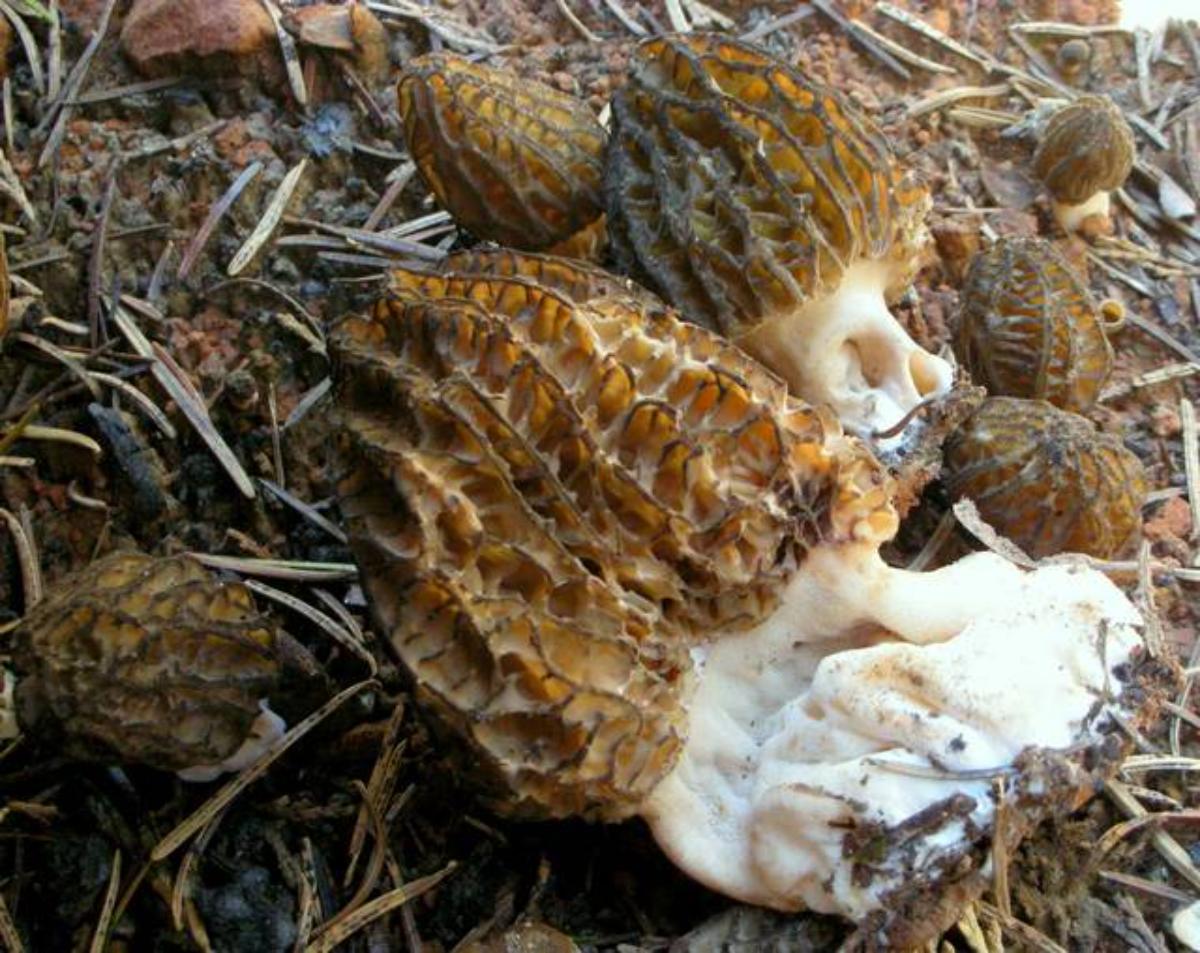
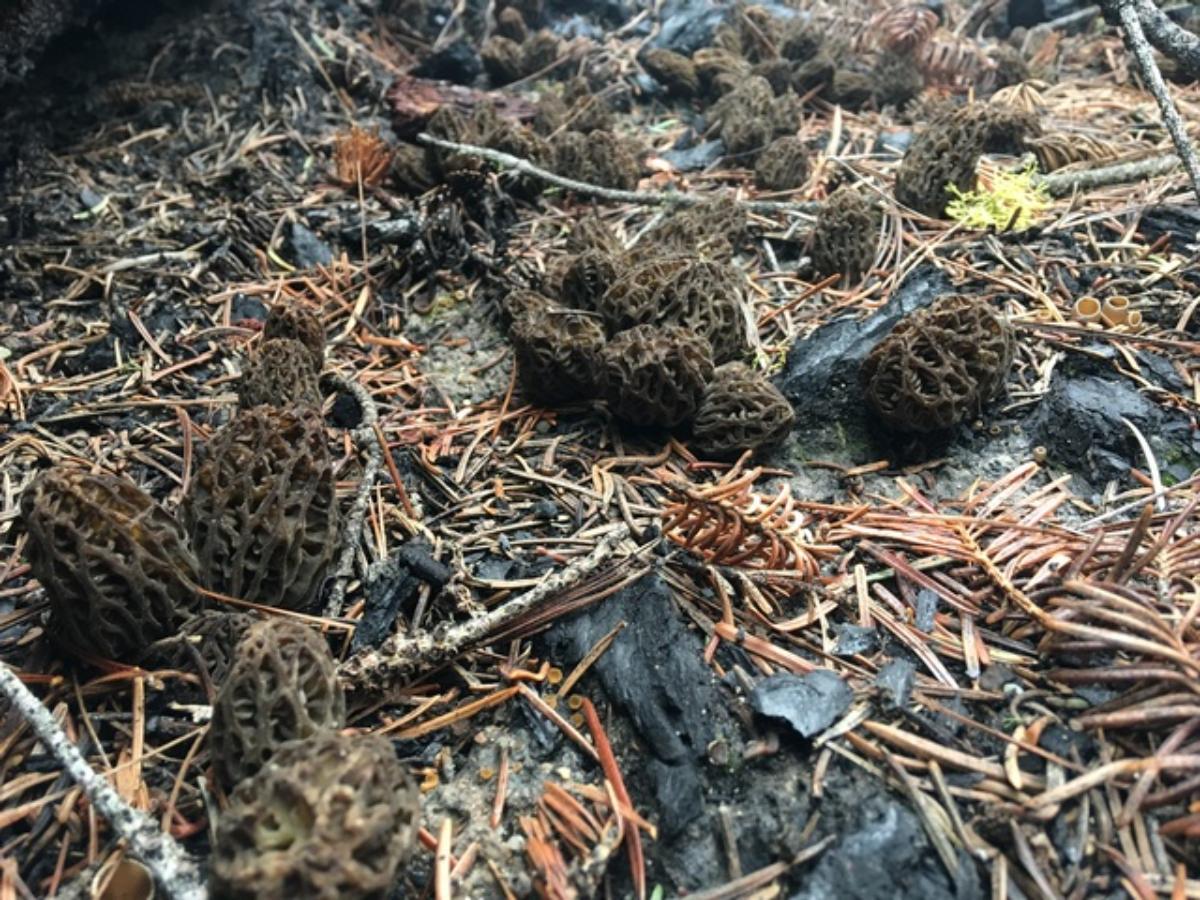
Morchella capitata, a.k.a Morchella exuberans
This morel is strikingly similar to M.sextelata and M.septimelata, the other burn-site morels.
- Region: western North America
- Season: Spring or summer
- Habitat: Burned spruce and fir forests, possibly other conifer burns
- Size: Stem – 1-2 inches long; Cap – 1 ½ – 3 ¼ inches tall.
- Description: Ridges and pits are olive or brown when young. They turn dark brown to black with maturity, and pits become brownish. Commonly called greenies or pickles by foragers. This species is extremely similar to two other burn site morels (M. sextelata and M. septimelata). There is one distinguishing feature – the stem of M. capitata has chambers and layers. The other burn site morels do not have this. The stem must be cut lengthwise to see this.
Morchella tomentosa
This one stands out from other burn-site morels because when it is young, it is super fuzzy.
- Region: Western North America, high elevations
- Season: Spring
- Habitat: Burned conifer forests, appearing in the spring after the burn
- Size: Stem – ¾ – 2 ½ inches tall; Cap – 1 – 4 ¼ inches long.
- Description: Distinguishable from other burn morels when young because it is covered entirely in fine, dense hairs. This gives it a very fuzzy appearance. As it ages, the hairs disappear. Ridges and pits start out gray, leading many foragers to call it a gray morel. The ridges and pits turn black, dark-gray, and sometimes white-ish as it matures.
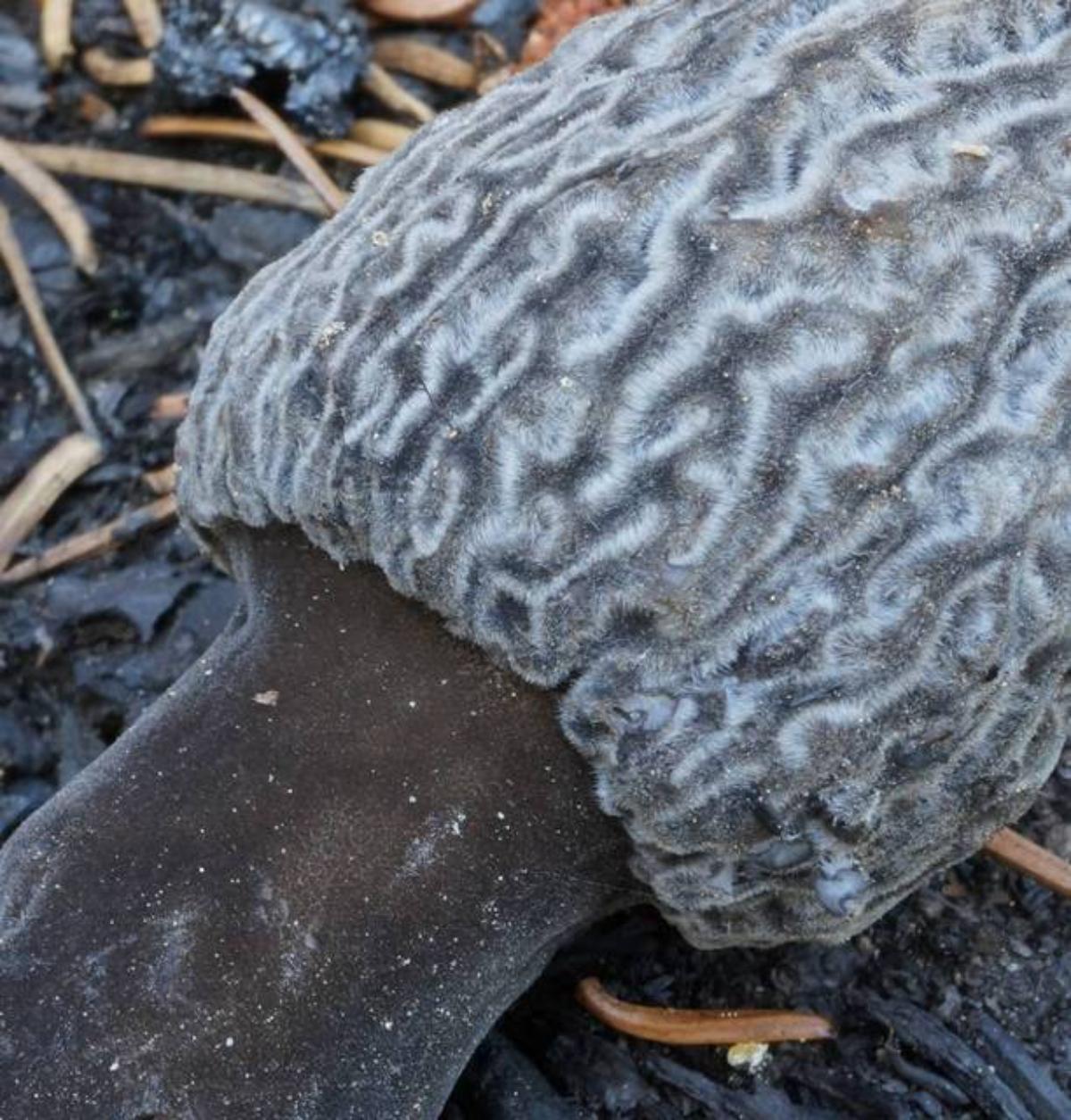
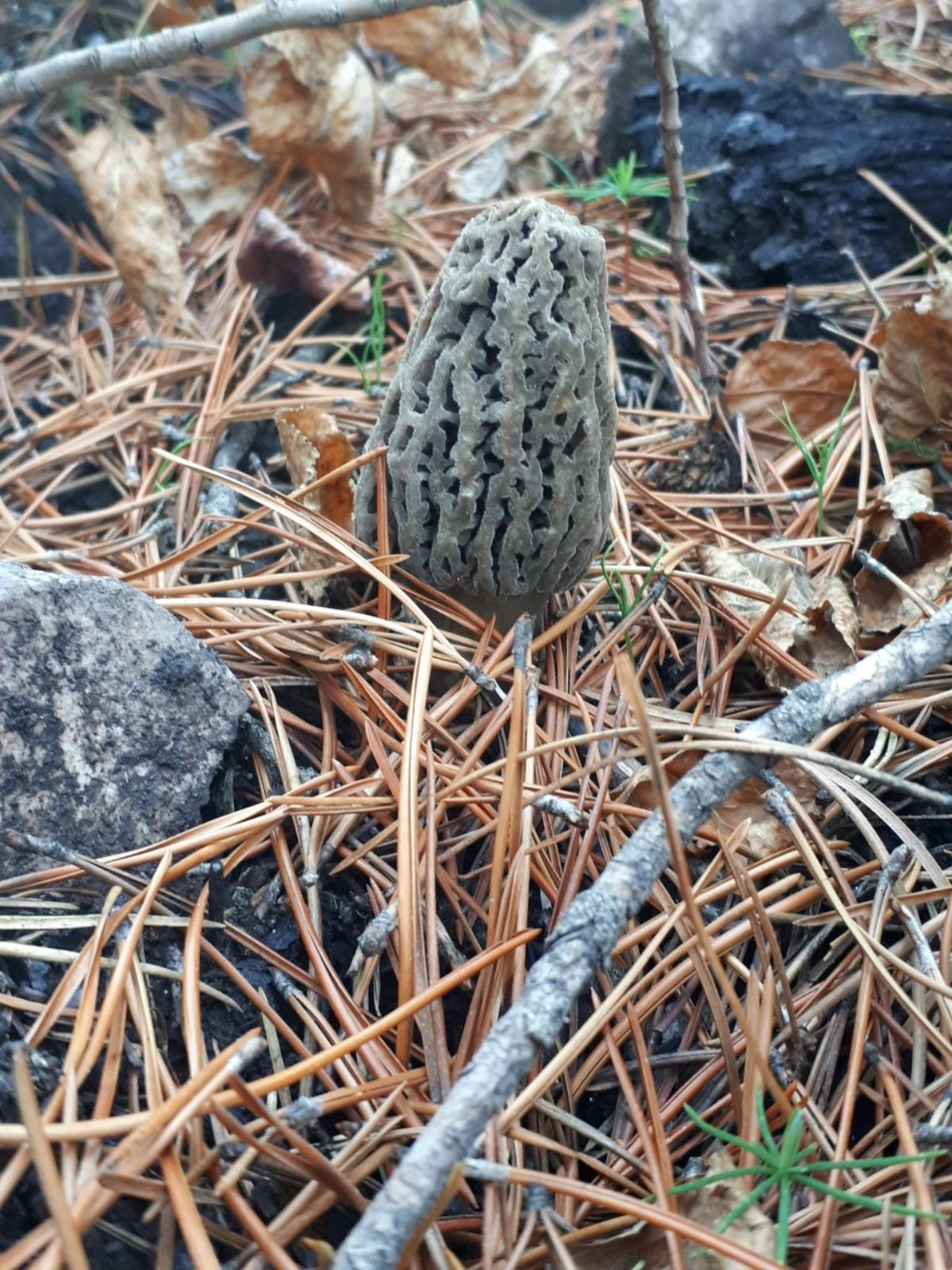
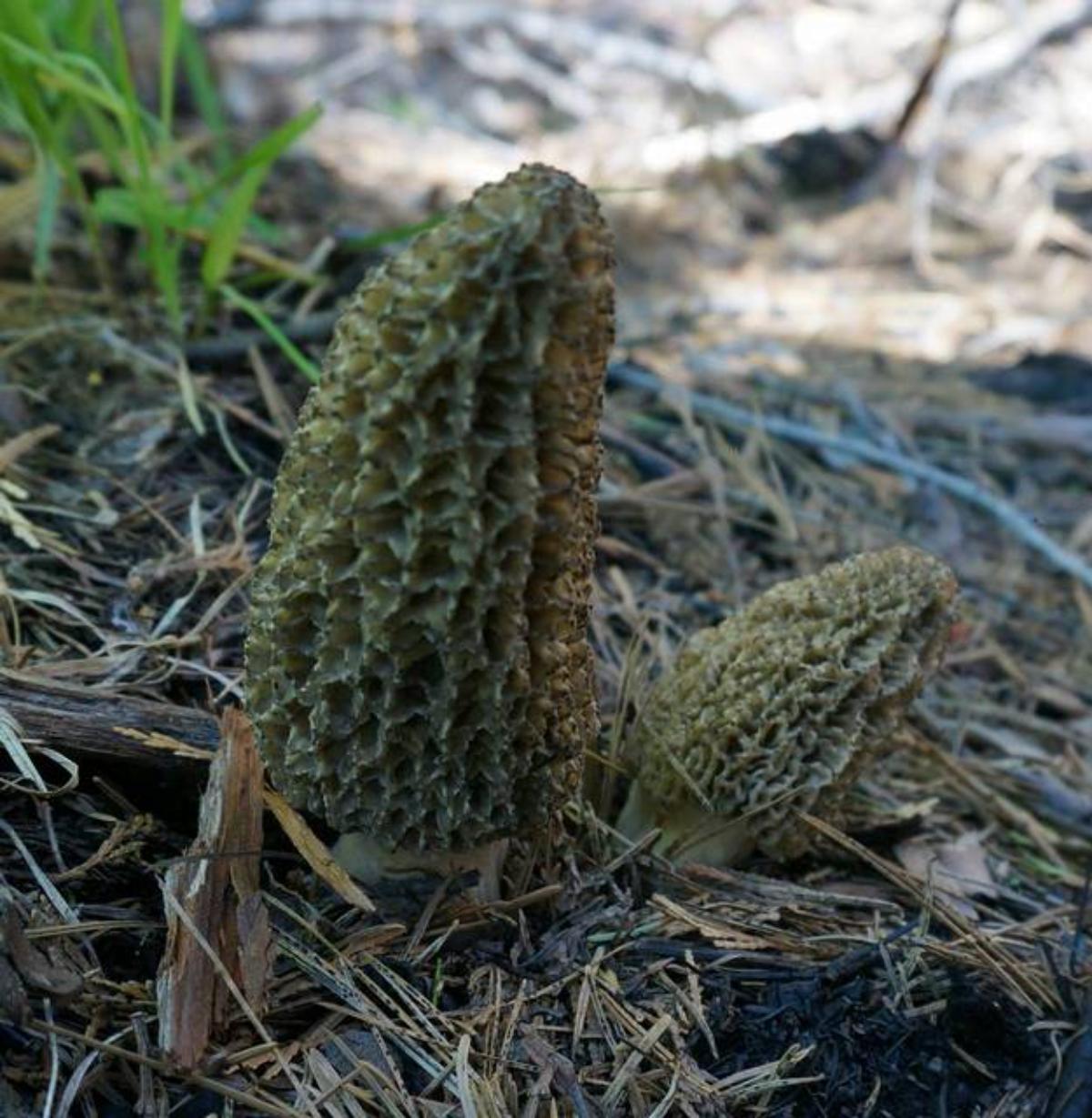
The Lone White Morel
Morchella rufobrunnea
This morel was discovered initially and notated by mycologists in Mexico. Since then, it has been found in coastal California and Oregon and is likely to have a wider distribution than is currently known.
- Region: Coastal California and Oregon.
- Season: Winter and early spring.
- Habitat: Landscaping sites, following a year after the ground is disturbed. Gardens, woodchip beds, planters, and along roadsides.
- Size: Stem – ¾ – 3 ½ inches tall; Cap – 2 ½ – 4 ¾ long.
- Description: A sizeable distinctive morel that grows in urban, suburban, and rural areas. Ridges are vertically aligned and white (or close to white) when young, and the pits are dark brown or black, creating a striking visual contrast. As it matures, the ridges and pits become yellowish-brown. The stem base is sometimes swollen. White morel caps and stems stain orange or rusty brown when bruised.
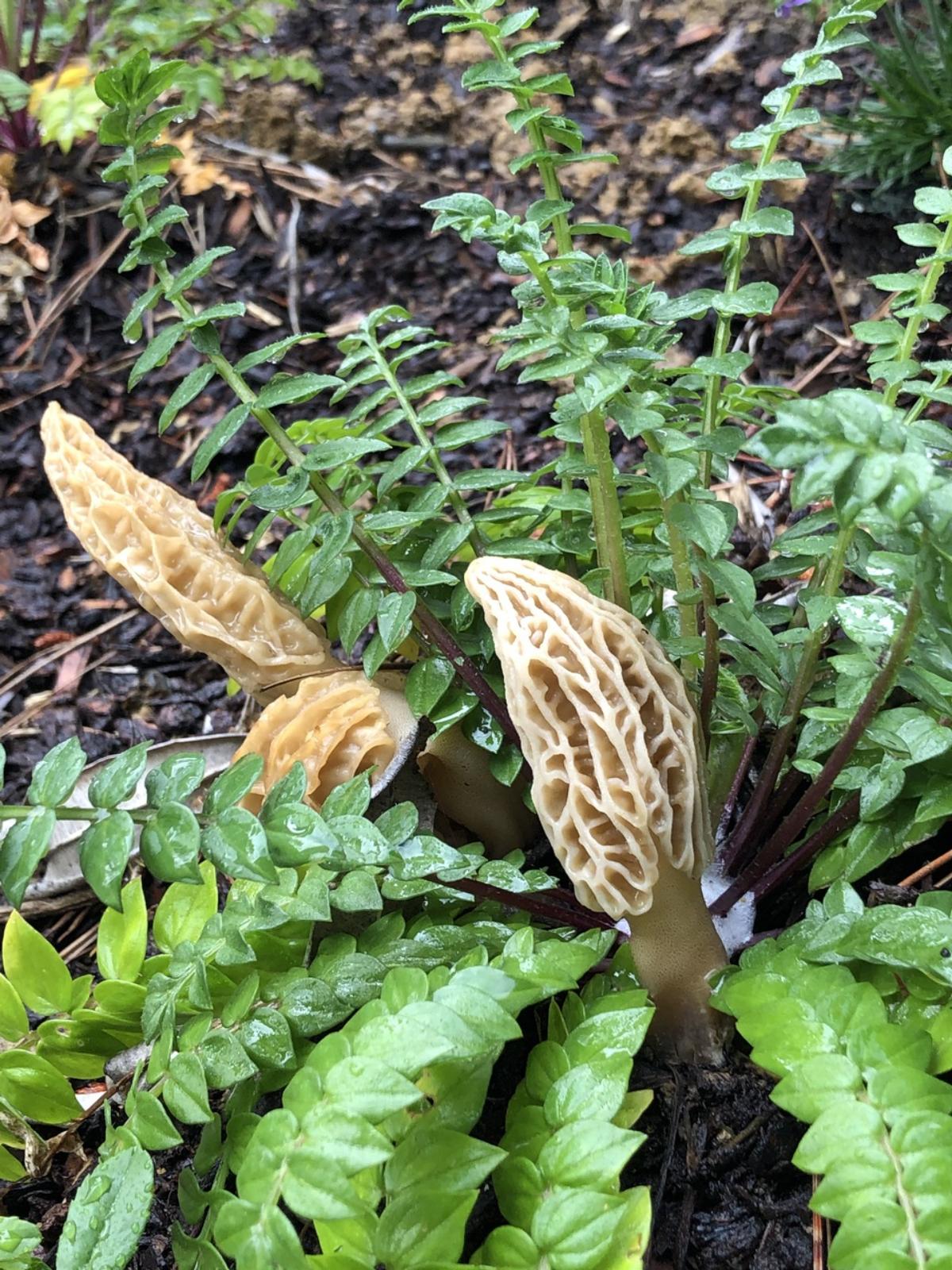
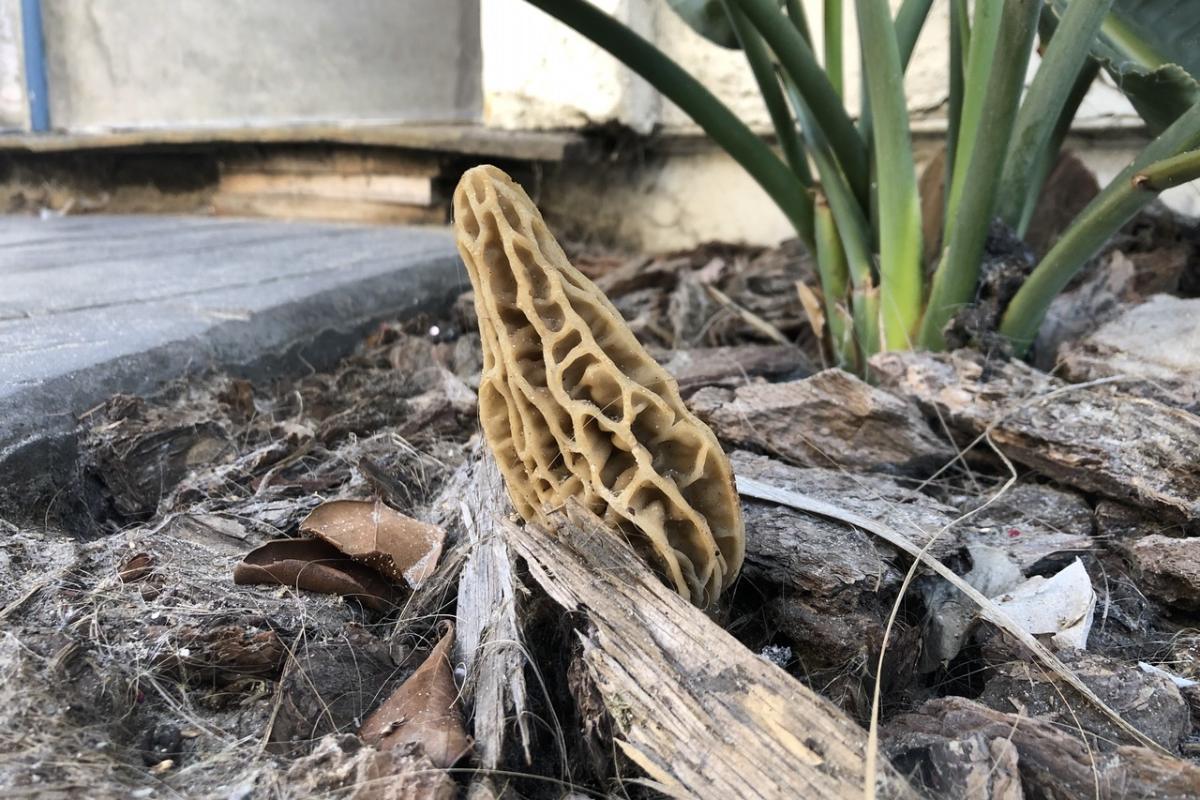
Morel Mushroom Trivia
- All the black morel species are split by the Rocky Mountains, appearing only on one side or the other.
- Two black morel species have tiny caps; they’re called half-morels. They look like they’re wearing beanie caps.
- There are four species of black burn morels, and they only grow in the western states.
- One morel species, the white morel, doesn’t grow in association with any trees. This one breaks the morel mold in so many ways!
- There is no such thing as gray morel. Some morel species are gray in coloring when young, but this is not a species determination. The “gray:” morels are actually immature yellow or black morels.
- Greenies and pickles are not morel species. These common terms were given to black burn morels, which appear greenish or olive-green when young.
- There’s a hairy morel! (M.tomentosa)
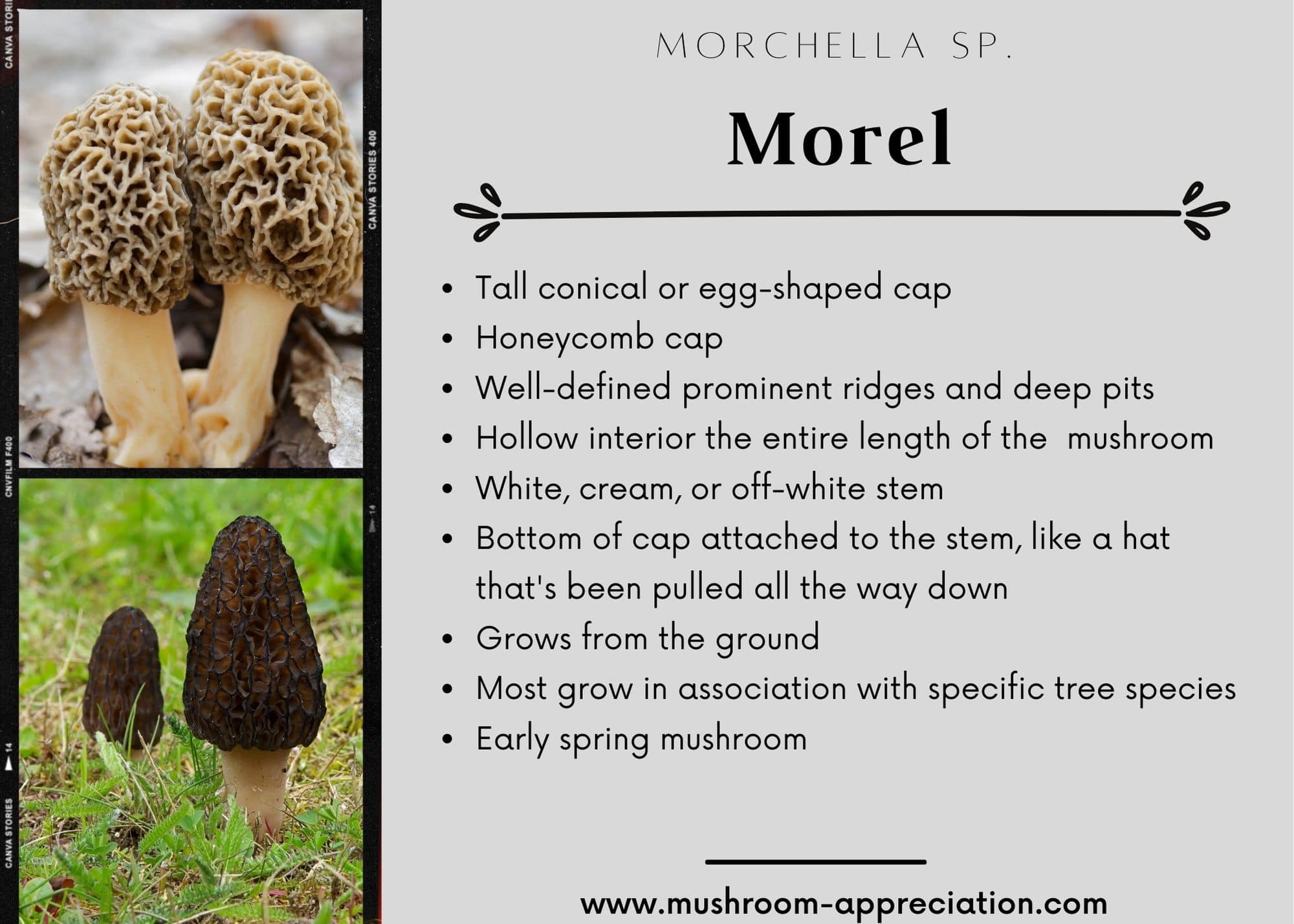
Morel Mushroom Common Questions and FAQs
Which morel is gray?
Three yellow morel species have gray coloring when they are young, M. americana, M.cryptica, and M.virginiana. They will change color as they mature. Scientifically speaking, there is no such thing as a gray morel.
What is the greenie morel?
Greenie and pickle are common names applied to two types of black burn morels which are olive or olive-brown colored when young, M.sextelata and M.septimelata.
What’s the best way to find morels?
Look up your region and determine which morels grow in your area. Then, study their habitat and seasonal preferences to know the best places to look and when to start looking.
Remember, morels appear in southern states earlier than in northern states. Morels usually only grow for 3-4 weeks in each region. So, when the guide says March-May, it means March for southern areas and May for more northern regions. That’s why there is a range; it does not mean that they will grow for all of those months in your location.
How can I be successful foraging morels?
Knowledge is power! Learn the land; learn where to look based on which species grow near you, and you’ll have much better success. So much depends on where you live. For example, looking for white morels in the Pacific Northwest won’t get you very far. And, vice versa, seeking burn morels in North Carolina will get you nothing.





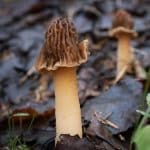
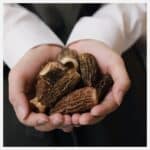
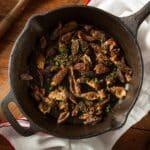
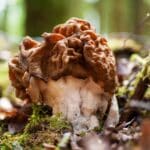
Tony O. says
Nice body of information. Thanks!
Jenny says
You’re welcome! We’re just a wee bit obsessed with fungi over here 😉
abdullah says
hi thanks for valuable information
Jenny says
You are very welcome!
Rick Phillips says
I live in southern Indiana not far from Cincinnati Ohio. What’s best to use for determining if my area is good use. I have a 3-4arcres I live on
Jenny says
I’m not sure what you’re asking…?
Elijah Bragg says
In my experience they like to be around trees, especially dead trees, stumps, and old fruit trees. What makes them grow, I do not know.
Northern Wild Harvest says
Hey great article on morel species, it’s very spot on and correlates with my first hand experience more than most articles I’ve read. Our harvesting group is located out of western Canada, primarily harvesting morels between southern BC and the northern Yukon (we cover a large area about 3000km x 1500km) harvesting burn morels.The oldest member of our harvesting group has been commercially working on burns for over 35 years. Having dried over a million lbs, we have had the privilege of admiring morels from all over Canadas western wilderness. The so called “superspecies” septimelata/sextelata/eximia, which look similar to many natural black morels in the elata clade, generally come up for a few weeks to start the burn flush here. The tomentosa and exuberans/captitata are the real stars of the show, they are different in appearance to non-burn morels and they almost always fruit after the other burn morels. Here, we only call Morchella exuberans “greenies” and they are distinguished when young by their unique silvery sheen with olive undertones, we don’t call the other species greens up here in the north. To me, the tomentosa is a personal favorite because it starts off jet black in some cases and can change to completely blonde as it matures, and yet other times it stays grey when mature – it breaks all the rules. Keep up the good work, we appreciate your appreciation for mushrooms! 🙂
Jenny says
Thank you! It’s excellent to hear first hand accounts too, especially from long time foragers. That’s a huge range you’ve got; I know it’s hard work harvesting but I’m super jealous :-). So many fungi break the “rules” we have set up for them. I think Mother Nature scoffs at our insistence on setting rules lol. Thanks again and here’s to a fantastic foraging season with boatloads of morels in your buckets!!
Glenn trumble says
Hi great article for all morel lovers, even experienced pickers! I do have one possible exception. Here in norther Michigan we sometimes find huge flushes of black morels the year after forest fires. They are different than the naturals that are plentiful in the aspens.
Jenny says
Fascinating! If I remember correctly from my readings, michigan seems to be a hotbed of species, including morels. I wonder if the michigan burn morels are same as the PNW ones. Or whether they’re one of the others common in Michigan just taking advantage of the rich burned area.
Angela Dansie says
We found that the tomentosa has a distinctive flavor & texture that is my personal favorite. So much so that I preserve them separately for special occasions
Jenny says
That’s very interesting! I’ve never actually heard anyone discuss the different tastes of the morel species, though I’ve always wondered. What is the flavor like, compared to the other species — what makes it distinctive?
Lorenzo Lo Piccolo says
Great article Jenny. I see many north European species in high altitudes and latitudes also have a “fuzzy” look. As if nature knows how to protects species from low temps.
Jenny says
Thank you! That is a very cool observation. I hadn’t thought of it but that totally makes sense — a defense mechanism from the cold. Nature truly is amazing
Vlad Lekach says
Hi Jenny,
The pic of what you call M. sextelata is actually a mature M. tomentosa, as it says on MO, and greenies are M. exuberans.
-V
Jenny says
Thank you Vlad for noticing that — I must have gotten the images mixed up when I was arranging them. Fixed now! And thank you so incredibly much for allowing open use of your images; it is so appreciated and makes such a difference when learning to differentiate between species
Pramodi says
Thanks for the information.